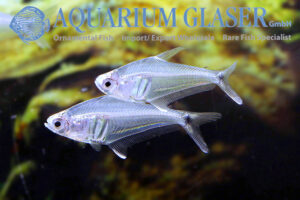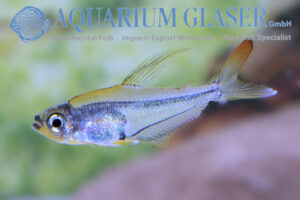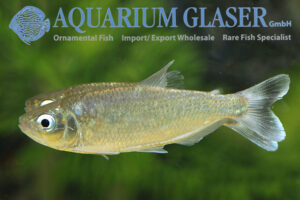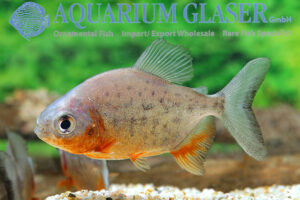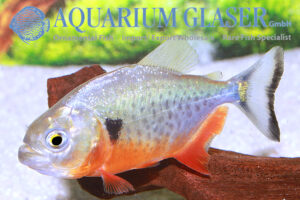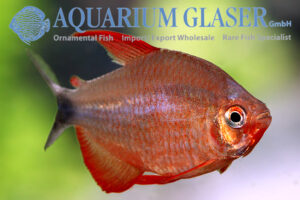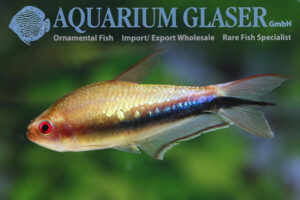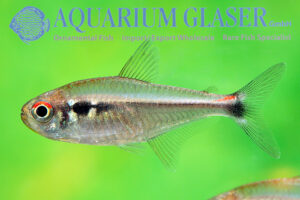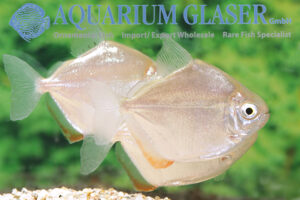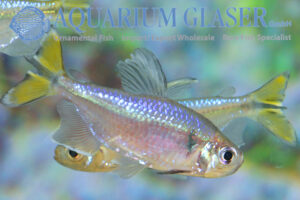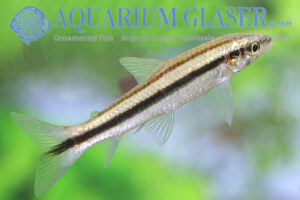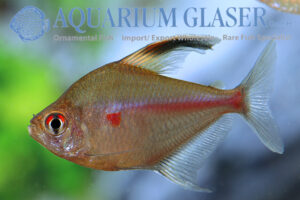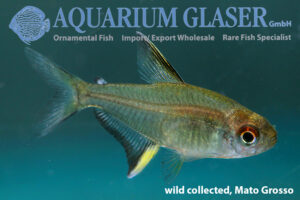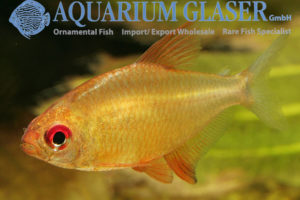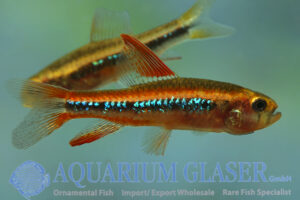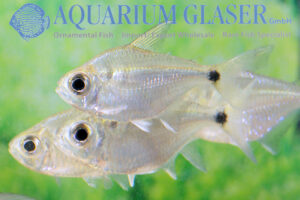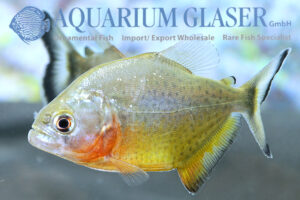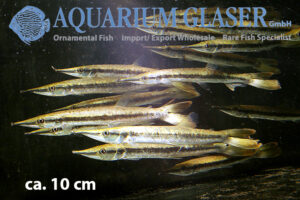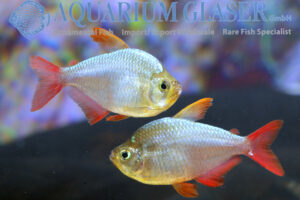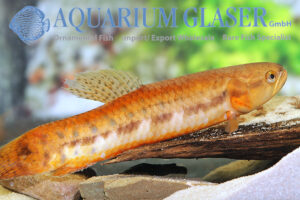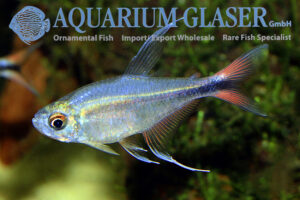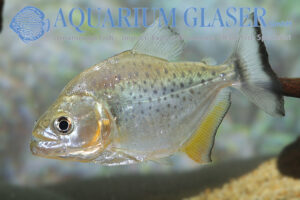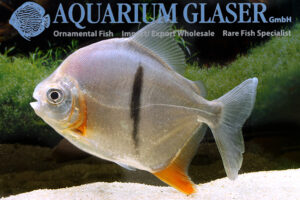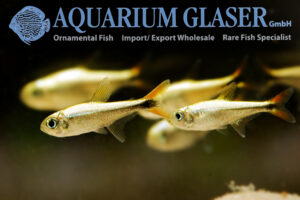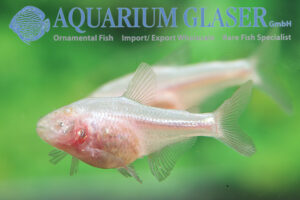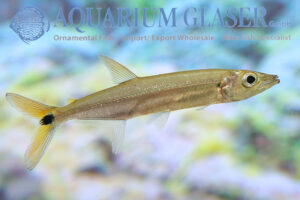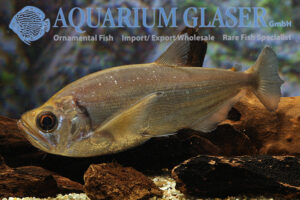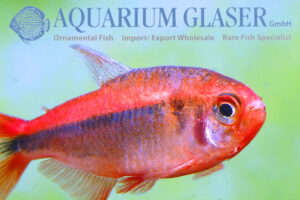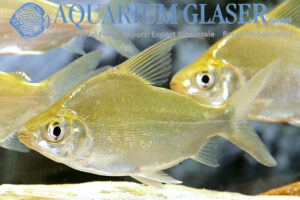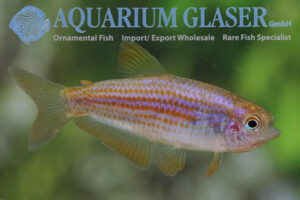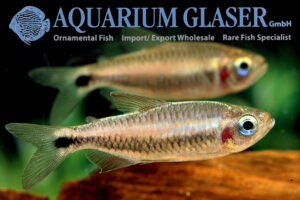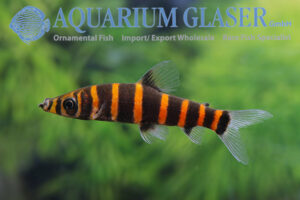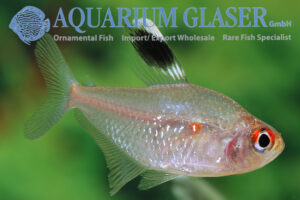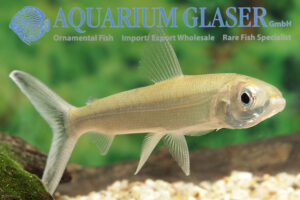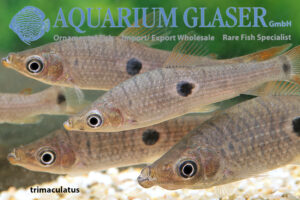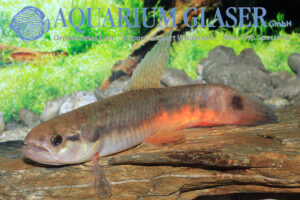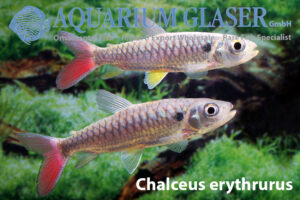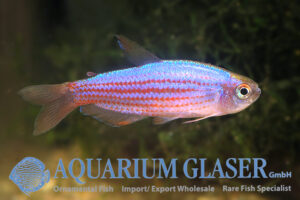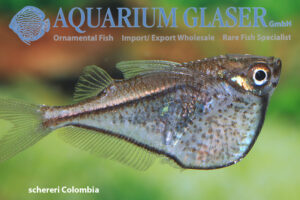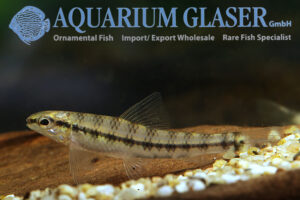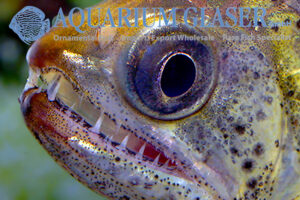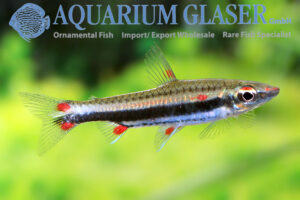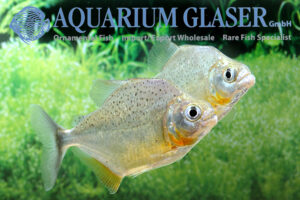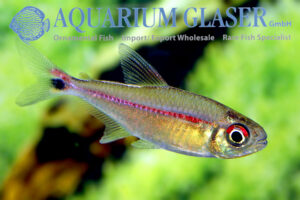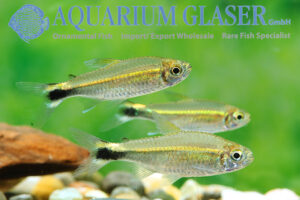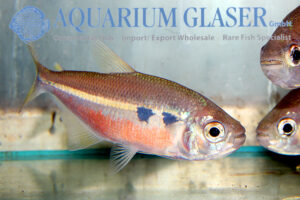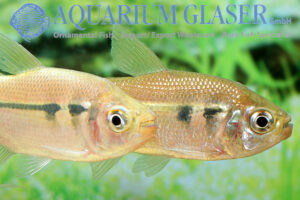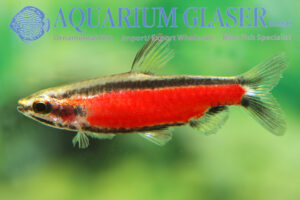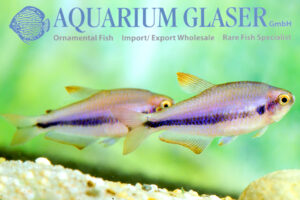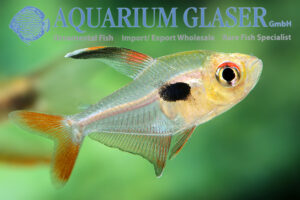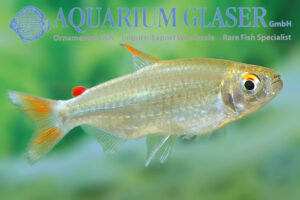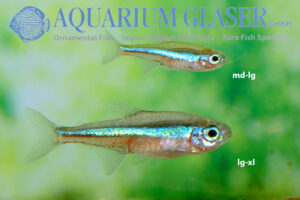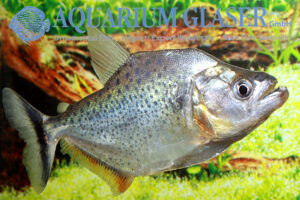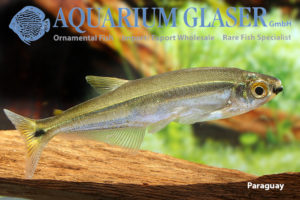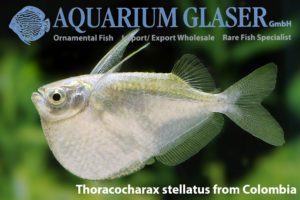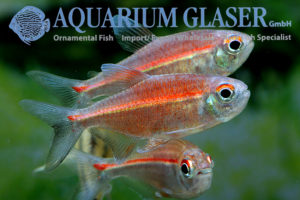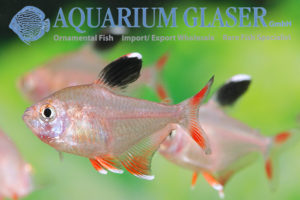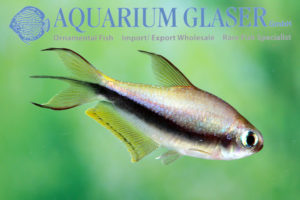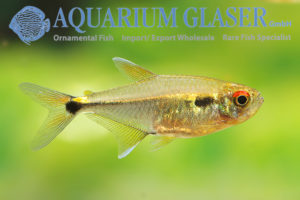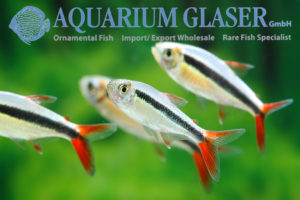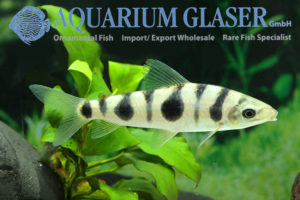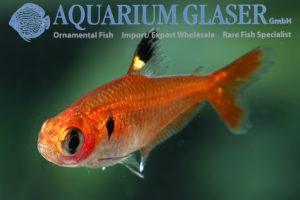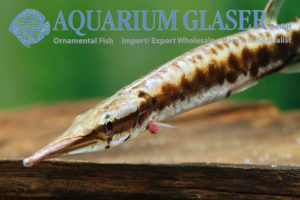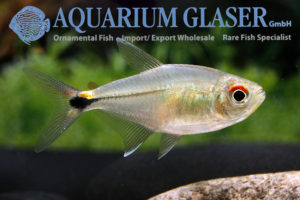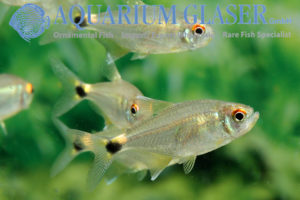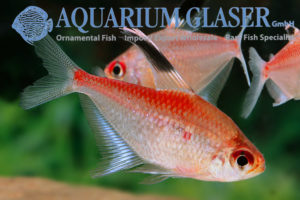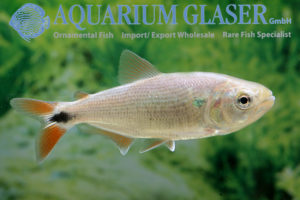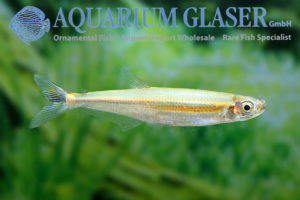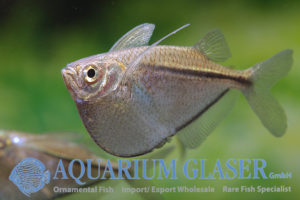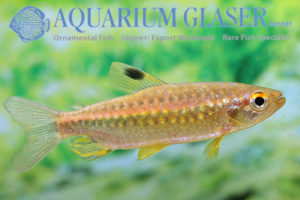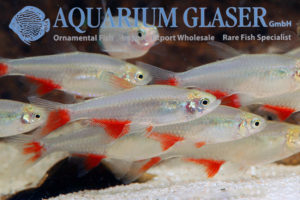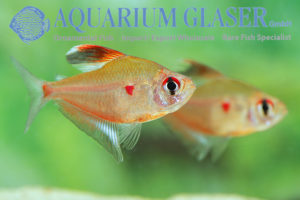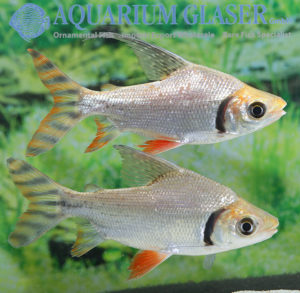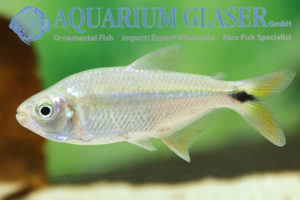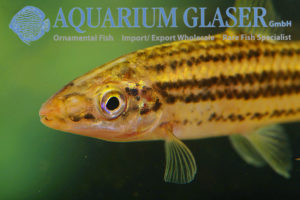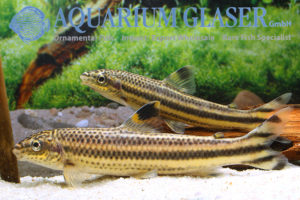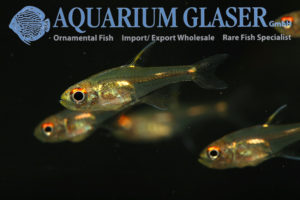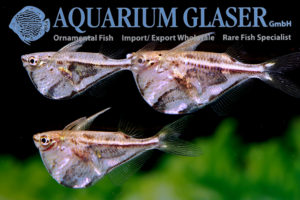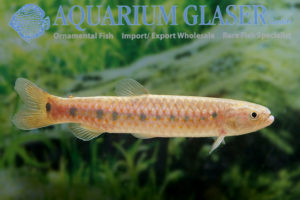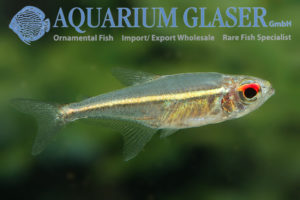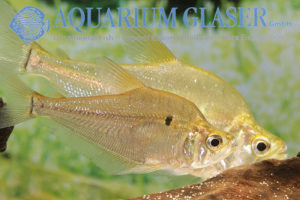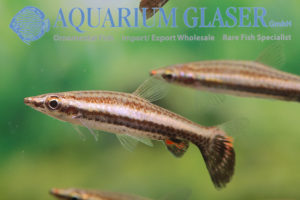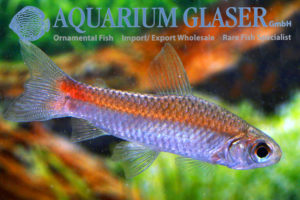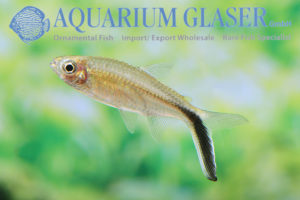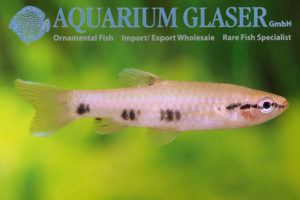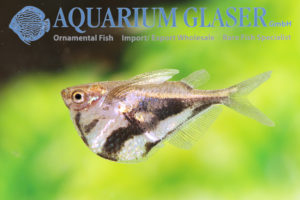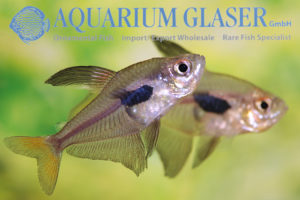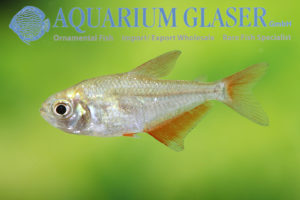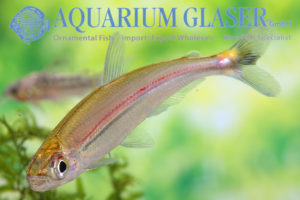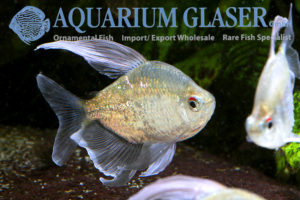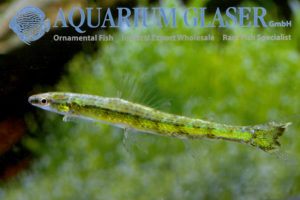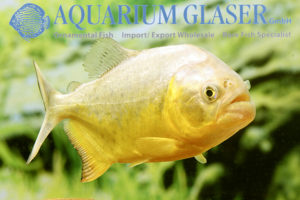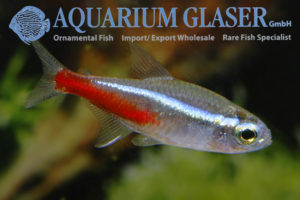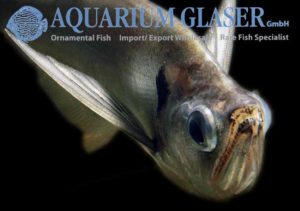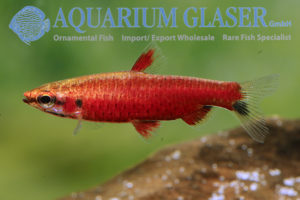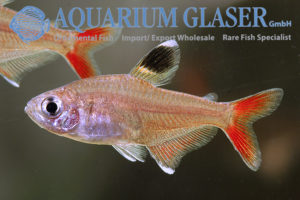In 1977 the „bible for all characin friends“ was punblished: Jaques Géry´s „Characoids of the world“. Almost at the end of this book a picture of a so far undescribed glass tetra was published that had an extremely unusual air bladder. This animal was described only one year later – in 1979 – by Richard […]
09. Characoids: tetra relationship (490)
-
-
Trochilocharax ornatus
We were able to import this cute dwarf tetra from Peru for the first time in April 2003. Since then, we have succeeded in importing it from time to time. The fish was initially provisionally called “Heterocharax sp. – Orangefin Tetra” or “Hummingbird Tetra”, sometimes also referred to as “Tyttocharax sp.”. A. Zarske scientifically described […]
-
Brycon cf. pesu1
The genus Brycon comprises around 45 species, which are distributed across large parts of South and Central America. They hardly play a role in aquaristics, but are very important as food fish. They are medium-sized to large fish. The smallest species belong to the B. pesu complex (approx. 16 cm standard length, i.e. without caudal […]
-
Piaractus brachypomus
Internationally, the largest serrasalmid species are called “pacu”: the red bellied pacu (Piaractus brachypomus, formerly Colossoma brachypomus or C. bidens) from the Amazon system, its twin species P. orinoquensis, which has only been differentiated from it since 2019, the yellow pacu (P. mesopotamicus) from the Parana-Paraguay system and the black pacu or cachama (Colossoma macropomum) […]
-
Pygocentrus cariba ( = P. notatus)
Pygocentrus are the most famous and aquaristically most important piranhas. In contrast to all other piranhas, Pygocentrus are always schooling fish. They are less keen on fin pieces of other fish than Serrasalmus and Pristorycon species and with their particularly sharp teeth they can bite whole pieces out of a body. However, the Pygocentrus species […]
-
Hyphessobrycon peugeotorum ( = H. peugeoti)
It’s amazing how many new, attractive tetra species have been discovered recently! Among them is Hyphessobrycon peugeotorum, which was only scientifically described in 2013 under the name H. peugeoti. It originates from the Brazilian state of Mato Grosso (middle drainage of the Rio Juruena, upper basin of the Rio Tapajós). The unusual species name does […]
-
Nematobrycon lacortei
The Rainbow Emperor Tetra (Nematobrycon lacortei) is certainly one of the most attractive tetras in South America. Its home is in western Colombia where it is caught in the catchment area of the Rio San Juan. Males and females can be easily distinguished by the color of the iris. Already in small juveniles the males […]
-
Hyphessobrycon montagi
With over 130 species, the genus Hyphessobrycon has become very confusing. New species are still being discovered. It has long been known that Hyphessobrycon is an artificial collective genus and that the species in it are not necessarily closely related to each other. For this reason, “groups” have been defined within Hyphessobrycon from time to […]
-
Metynnis “hypsauchen” ( = M. altidorsalis)
Silver dollars are the herbivorous counterparts to the carnivorous piranhas. Among them, the genus Metynnis – recognizable by its long, flat adipose fin – is the most important aquaristically, as its members still fit reasonably well into standard aquariums with a final size of 15-20 cm. Representatives of other genera can grow considerably larger. One […]
-
Alestopetersius caudalis
The yellow Congo tetra (Alestopetersius caudalis) is a popular and frequently offered ornamental fish. The species originates from the Congo, where it is at home in the lower reaches of the African river. Wild-caught fish are very rare in the trade. The species was first imported around 1950 and was soon bred. The animals in […]
-
Parodon sp. cf. pongoensis
The Parodontidae are a relatively small group of bottom-dwelling tetras. The family consists of three genera with a total of approx. 32 species. The genera are distinguished from each other by two characteristics: firstly, the number of unbranched rays in the pectoral fin: one each in Parodon and Apareiodon and two in Saccodon; and secondly, […]
-
Megalamphodus erythrostigmus = Hyphessobrycon erythrostigma
The regrouping of large fish families continues. After the barbs, armored catfish and cichlids, it’s now the turn of the characins. A major revision was published in September 2024, prompting us to retrain once again. Not all tetra species have been included yet, so it will certainly take a few years before the new name […]
-
Hyphessobrycon pulchripinnis
The lemon tetra, Hyphessobrycon pulchripinnis, is one of the most popular aquarium fish of all and can be found in the standard range of pet shops all over the world. As with so many everyday species, little thought is given to them, but the lemon tetra holds many secrets! Its native habitat was unknown until […]
-
Hyphessonbrycon cf. pulchripinnis “Bolivia Orange”
The lemon tetra, Hyphessobrycon pulchripinnis, is one of the most popular aquarium fish of all and can be found in the standard range of pet shops. As with so many everyday species, little thought is given to them, but the lemon tetra holds many secrets! The ancestors of the animals that we can occasionally offer […]
-
Poecilocharax weitzmani
Of course, this fish is anything but a novelty and has been imported in relatively large numbers for many years. But isn’t it beautiful? This small animal is an ideal companion for the cardinal tetra (Paracheirodon axelrodi), with which it also occurs in the wild. Poecilocharax weitzmani grows to 3-4 cm and is relatively widespread […]
-
Tetragonopterus denticulatus
The genus Tetragonopterus used to be the catch-all for all smaller tetra species, which are now found in the genera Hemigrammus, Hyphessobrycon or Moenkhausia, for example. The English term “tetra” for all tetras, an abbreviation of Tetragonopterus, has survived. Nowadays there are only 14 species of Tetragonopterus, of which only T. argenteus can be considered […]
-
Serrasalmus spilopleura
The correct naming of piranha species is one of the most difficult chapters in fish systematics. Even the scientists specializing in this group of fish are by no means in agreement. And so we often have little choice but to identify a newly imported piranha according to the few external characteristics that are generally recognized, […]
-
Boulengerella cuvieri
The elegant predatory tetras of the genus Boulengerella are divided into 5 species: B. cuvieri, B. lateristriga, B. lucius, B. maculata and B. xyrekes. They are widely distributed in the large river systems of the Amazon and Orinoco and the Guyanas. Distinguishing the species is not easy, especially with small juveniles. Juveniles of B. cuvieri […]
-
Hyphessobrycon columbianus
Hyphessobrycon columbianus was described by Zarske & Géry in 2001. According to Weitzman, the fish belongs to the “Rosy Tetra group” (in the broadest sense “ornamental tetra relatives”). The first specimens arrived in Germany in 1995, caught in a tributary of the Rio Acanti, Colombia. All specimens currently on the market are said to be […]
-
Erythrinus sp. Orinoco
The predatory tetras of the genus Erythrinus should be easy to identify, because from a scientific point of view only two species are accepted: E. erythrinus, which inhabits virtually the entire tropics and parts of the subtropics of South and Central America, and E. kessleri, an endemic (i.e., occurs only there) from the state of […]
-
Hemigrammus filamentosus
In 2010, we were able to import a new tetra from Brazil via Belem for the first time, which could not be clearly assigned to any scientifically described species. It was provisionally named Hyphessobrycon cf. stegemanni and Phoenix tetra. Today we know that the species originates from the Rio Araguaia. The maximum length is 3-4 […]
-
Serrasalmus gibbus
The piranha species Serrasalmus gibbus comes from the catchment of the Rio Tocantins, it was described from the Rio Araguaia. The animals that we currently have in stock were delivered with the location Guama. The Rio Guama is a 160 km long tributary of the Tocantins in the state of Pará, Brazil. The species is […]
-
Myloplus sauron (formerly Myleus schomburgkii)
The title of this post is perhaps a little misleading; it is intended to indicate that the species recently scientifically described as Myloplus sauron has been known in the hobby as Myleus schomburgkii for around 100 years. However, M. schomburgkii still exists. Back in 2004, the genus Myloplus was separated from Myleus and M. schomburgkii […]
-
Hyphessobrycon saizi (“Hyphessobrycon eos”) Colombian gold tetra
The most common “gold tetra” in the trade comes from Colombia and is generally traded under a false name. It can be found in the trade up and down the country for little money under the name Hyphessobrycon eos (sometimes also as Hemigrammus eos). The species Hyphessobrycon eos actually exists, but it is not kept […]
-
Blind cave tetras
In 1936, an ornamental fish catcher named C. Basil Jordan discovered blind tetras in a cave in the Mexican state of San Luis Potosi. He managed to catch 100 specimens and bring them to the USA without any losses. This discovery was a sensation, as it was the first blind cavefish belonging to the tetra […]
-
Acestrorhynchus microlepis
The pike characins (Acestrorhynchus) belong to the obligatory predatory fish among the tetras. They only eat carnivorous food, preferably fish. There are currently 14 recognized species. The smallest species are barely 10 cm long, the largest 35-40 cm. With an expected final size of 20-30 cm, A. microlepis is one of the medium-sized species. In […]
-
Hydrolycus wallacei
The genus name “Hydrolycus” means “water wolf”. These sabre-toothed tetras are indeed impressive predatory fish and anyone who is interested in predatory fish and can provide the appropriate space – Hydrolycus species grow to between 40 and 120 cm in length – will have exciting fish to keep at home. For obvious reasons, however, such […]
-
Hyphessobrycon myrmex
A great aquarium future can be predicted for this new dwarf tetra – it barely reaches a total length of 3 cm – now that breeding has been successful and the initially rather expensive rarity is coming onto the market in large numbers. The brilliance of the colors in this little animal is really quite […]
-
Cyphocharax abramoides
The genus Cyphocharax comprises 48 species and has a very wide distribution in South America. However, only one species has become known aquaristically, namely C. multilineatus (https://www.aquariumglaser.de/en/09-characoids-tetra-relationship/cyphocharax-multilineatus-4/). This species is attractively marked. However, the majority of Cyphocharax species offer little incentive to keep them in the aquarium, as they present themselves as silver-colored, colorless animals […]
-
Inpaichthys parauapiranga now available!
Finally we received the eagerly awaited Inpaichthys parauapiranga offspring. They are beautiful, already sexually mature animals. We took the pictures for this post of exactly these specimens. They are already wonderfully colored, and this will certainly increase with well acclimatized animals. For pictures of the parents see here: https://www.aquariumglaser.de/en/fisharchive/coming-soon-inpaichthys-parauapiranga/ For our customers: the animals have […]
-
Moenkhausia cosmops
After many years, we have once again received one of the most extraordinary tetras in Brazil: Moenkhausia cosmops. This species was only scientifically described in 2007. Until now it has only been known from the upper reaches of the Rio Paraguai and Rio Tapajos basins in the state of Mato Grosso: Rio Juba, Rio Juruena, […]
-
Synaptolaemus latofasciatus
Finally we managed to import again some specimens of this unusual “striped sock” from Venezuela. The species – there is just the one in the genus Synaptolaemus – was long known under the name S. cingulatus, until Britzki et al. discovered that the species described as Leporinus latofasciatus by Steindachner in 1910 was identical with […]
-
Hyphessobrycon pyrrhonotus JUVENILE
There are three species of the so-called bleeding heart tetras. They all have a pink to cherry-red spot in the middle of the front half of the body. Adult specimens of Hyphessobrycon erythrostigma (upper Amazon, imported from Peru, see https://www.aquariumglaser.de/en/09-characoids-tetra-relationship/hyphessobrycon-erythrostigma-2/), H. socolofi (Rio Negro catchment, Brazil, see https://www.aquariumglaser.de/en/09-characoids-tetra-relationship/hyphessobrycon-socolofi-var-green-2/) and H. pyrrhonotus (also Rio Negro catchment, […]
-
Hemiodus immaculatus
Caught! In the past, a few feather tetras of the species Hemiodus immaculatus came to us as bycatch together with the very rarely imported species Argonectes longiceps (https://www.aquariumglaser.de/en/09-characoids-tetra-relationship/argonectes-longiceps-2/). Both fish look very similar and apparently form a symbiotic relationship in nature. How exactly this symbiosis works, however, is still completely unexplored. Now we have once […]
-
Pseudanos trimaculatus
The genus Pseudanos was separated from Anostomus in 1980 due to numerous differences in the skeleton. At that time, the scientist in charge, Richard Winterbottom, assigned two already known species to the new genus – P. gracilis and P. trimaculatus – and another, which he described as new: P. irinae. The differences between P. trimaculatus […]
-
Erythrinus sp. Madre de Dios
This magnificent Erythrinus comes from the drainage of the Madre de Dios, which is around 1,100 km long, lies between Bolivia and Peru and is the largest tributary of the Rio Madeira. The genus Erythrinus is in great need of revision. Nobody knows how many species there are and how they can be distinguished from […]
-
Chalceus erythrurus
Traditionally, a distinction is only made between two Chalceus species, one with a shoulder spot (C. erythrurus) and one without (C. macrolepidotus). The species with the shoulder spot has yellow ventral fins when sexually mature, at least the females. This classification has often led to confusion in the trade, as there are clearly more color-distinguishable […]
-
Coming soon: Inpaichthys parauapiranga
Only a short time after this wonderful new tetra has been given a name can we (almost) offer it. Inpaichthys parauapiranga was scientifically described in February 2024. Peter and Martin Hoffmann have successfully bred it and we will soon be able to offer these offspring. We are already looking forward to it! They are peaceful […]
-
Black-winged dwarf hatchets, Carnegiella marthae and C. schereri
There are two species of black-winged dwarf hatchets in South America. These cute fish only grow to around 3 cm in length. According to scientific data, both species are very widespread (Brazil, Ecuador, Colombia, Venezuela, Bolivia and Peru), Carnegiella marthae has been described from Venezuela (Caño de Quiribana, near Caicara) and C. schereri from Peru […]
-
Characidium steindachneri
With 97 described species, 67 of which are considered to be valid by the majority of scientists, the bottom-dwelling ground tetras (Characidium) are extremely species-rich. Unfortunately, there is no complete overview of the genus. Misidentifications or at least uncertainties prevail in both scientific and hobbyist literature. One of the most frequently cited species in the […]
-
Hydrolycus armatus Orinoco
Once more we were able to import this breathtaking animal from the Rio Orinoco. Anyone who is interested in this species should take the chance now, because this fish is available only a few weeks each year. For more informations on the species please see https://www.aquariumglaser.de/en/09-characoids-tetra-relationship/hydrolycus_armatus_en-2/ and https://www.aquariumglaser.de/en/09-characoids-tetra-relationship/hydrolycus_armatus_en/ For our customers: the animals have code […]
-
Nannostomus trifasciatus
Sometimes you almost forget how incredibly beautiful traditional aquarium fish are due to the large number of interesting and colorful new imports. The Threestripe pencilfish, Nannostomus trifasciatus, is one of the most beautiful of them all. According to the huge distribution area of the species (Bolivia, Brazil, Guyana and Peru), there are numerous color variants […]
-
Serrasalmus eigenmanni
The systematics of piranhas is undisputedly one of the most complicated and complex sub-disciplines of fish science (ichthyology). There are several reasons for this. Piranhas are extremely common and conspicuous fish that are very easy to catch. As early as the 18th and 19th centuries, several species were described and named, often based on individual […]
-
Hemigrammus rubrostriatus
In the past, we were only able to present this beautiful tetra, which was only scientifically described in 2015, as a rare by-catch (e.g. https://www.aquariumglaser.de/en/09-characoids-tetra-relationship/hemigrammus-rubrostriatus/). However, we are now able to import these beautiful fish from Venezuela on a regular basis, as we have done again recently. The approximately 4-5 cm long animals are fully […]
-
Hemigrammus hyanuary Wild
In 1957, when the first Green Tetras or Neon Costello (Hemigrammus hyanuary) were imported, the tetras were absolute fashion fish. Otherwise the comparison with the neon or cardinal tetra can hardly be explained, because H. hyanuary – which by the way is named after Lake Hyanuary in Brazil – is really nicely colored, but it […]
-
Jupiaba anteroides – follow-up
We recently introduced you to the Jupiaba anteroides from the Rio Cenepa in Peru, which we imported recognized for the first time (see: https://www.aquariumglaser.de/en/fisharchive/jupiaba-anteroides-2/) In the meantime, the few specimens still remaining with us have got into the mating mood and the males have taken on a quite astonishing mating coloration with a tomato-red belly. […]
-
Jupiaba anteroides
For a variety of reasons, aquariums were predominantly small until the 1960s and held 10-100 liters of water. Accordingly, aquarists focused on small fish. It was only when the cichlids of Lake Malawi were imported that the trend changed. These “coral fish of freshwater” need large tanks due to their high intraspecific aggressiveness and soon […]
-
Nannostomus sp. Cenepa Super Red
Recently we could present you a magnificent, deep red new pencil fish (see https://www.aquariumglaser.de/en/fish-archives/nannostomus-sp-super-red-2/). Thereby we mentioned a second species, the “Cenepa Super Red”, which we unfortunately only knew from internet pictures at that time. We now manage to import these magnificent animals on a regular basis. The “Cenepa Super Red” differs from the “Super […]
-
Inpaichthys sp. “Red Eye”
It’s amazing how many new and extraordinarily beautiful tetra species have appeared in recent years. Among them is an Inpaichthys species that has not yet been scientifically recognized and is referred to as the “Red Eye” by those who catch it. The I. sp. “Red Eye” differs from the well-known king tetra (I. kerri) not […]
-
Hyphessobrycon epicharis (2)
We recently succeeded in importing the species Hyphessobrycon epicharis, which had previously only been imported in very small numbers (see https://www.aquariumglaser.de/en/09-characoids-tetra-relationship/hyphessobrycon-epicharis-2/ and https://www.youtube.com/watch?v=RBofRyOLk3g). Now we have succeeded in importing once more that species that is unmistakable due to its distinctive shoulder spot. This time the animals are somewhat smaller (and therefore cheaper), but more colorful. […]
-
Micralestes humilis ( = “M. stormsi”)
Unfortunately, Micralestes humilis from Nigeria is only offered relatively rarely. This species, which belongs to the Congo tetras, is a wonderful contrasting fish for West African aquaria. The bright red adipose fin of this species is particularly striking. On the one hand, it serves to keep the shoal together, but is also confusing for predatory […]
-
Crenuchus spilurus
Crenuchus spilurus is the only formally described species of the genus Crenuchus. There is, of course, at least one other species in Venezuela (see https://www.aquariumglaser.de/en/09-characoids-tetra-relationship/a_new_species_of_crenuchus__en/). C. spilurus was originally described from the Essequibo River in Guyana. We have now once again received extremely beautiful specimens from Manaus (Brazil). In contrast to almost all other tetras, […]
-
Paracheirodon simulans lg-xl
The internationally since always Green Neon, in German also occasionally Blue Neon (to avoid confusion with Hemigrammus hyanuary, which is also called Green Neon) called Neon tetra Paracheirodon simulans we have more or less always in our assortment, see https://www.aquariumglaser.de/en/09-characoids-tetra-relationship/paracheirodon-simulans-2/ Now we have received from our supplier in Colombia comparatively extremely large specimens, as we […]
-
Serrasalmus irritans
Serrasalmus irritans is a slender piranha, described by the first describer Peters in 1877 as follows: “The area above the lateral line spotted black-blue. The caudal fin with a broad black-blue band enclosing the middle of the base, the broad margin yellow-white; the anal fin reddish, black at the margin. A specimen, 17 centimeters long, […]
-
Piabucus melanostoma
From Paraguay we received large (10-12 cm), unusual tetras. These elegant animals can be assigned without problems to the genus Piabucus, which according to current knowledge includes three species. Two of them are supposed to occur also in Paraguay, namely P. dentatus and P. melanostoma. In the past, it was thought that the two species […]
-
Thoracocharax stellatus
The platinum hatchetfish, Thoracocharax stellatus, is one of the more commonly imported yet mysterious species within the hatchetfish family. It appears to have an extremely wide distribution in South America. Scientific evidence exists from Argentina, Bolivia, Brazil, Colombia, Uruguay, Ecuador, Paraguay, Peru and Venezuela. So, regardless of state boundaries, these are the Paraguay/Paraná, Amazon and […]
-
Hemigrammus coeruleus
Although Hemigrammus coeruleus has a very wide distribution in Amazonia (Brazil, Ecuador, Colombia) and was scientifically described as early as 1908, it only entered aquariums in the early 2000s (at least recognized). H. coeruleus is a fish with two faces: in neutral mood it is pretty, but not spectacular and looks like a mixture of […]
-
Hyphessobrycon rosaceus (“ornatus”)
In 1997, the US ichthyologists Stanley Weitzman and Lisa Palmer published a scientific paper that caused a sensation among experts. In it, they described the new species Hyphessobrycon epicharis, but also commented in detail on a relationship group within the South American small tetras known as the “rosy tetra clade”. The authors showed, among other […]
-
Nematobrycon palmeri WILD
The Emperor Tetra (Nematobrycon palmeri) has been one of the most popular tetra species for decades due to its beauty and interesting behavior, and is available year-round as a captive breed. Wild catches, on the other hand, are only available for a limited time and on a seasonal basis. We have now once again received […]
-
Hemigrammus luelingi
Head-and-Taillight tetras were introduced to Germany as early as 1910 and were also bred soon after. They soon belonged to the iron stock of ornamental fish. Since then there are practically no more wild-caught imports. Now we have received head-and-taillights from Peru, which we initially mistakenly determined to be wild Hemigrammus ocellifer. Tetra specialist Flávio […]
-
Thayeria sp. Red Tail Teles Pires
Penguin tetras (Thayeria) are well known aquarium fishes. Of the scientifically accepted four species (T. boehlkei, T. ifati, T. obliqua, T. tapajonica) T. boehlkei is always on offer in the ornamental fish trade. Almost all of them are offsprings, although the species is widely distributed in South America (Peru, Ecuador, Brazil and Bolivia). The Rio […]
-
Leporinus pellegrinii
The large genus Leporinus comprises more than 90 species and still confronts science with hardly solvable problems concerning the delimitation of the species. Among the groups of species known for decades as particularly complicated is the group of forms around Leporinus maculatus. These are Leporinus, where at least a part of the flank pattern consists […]
-
Hyphessobrycon haraldschultzi
After a long time we could finally import some of the beautiful Hyphessobrycon haraldschultzi from the Rio Araguaia in Brazil. The animals are clearly slimmer than serpa tetras (H. eques, “serpae”, “minor” etc.). The coloration is more reminiscent of H. amandae, because the red is – unlike serpa tetras – not a rich blood red […]
-
Boulengerella maculata
The elegant predatory tetras of the genus Boulengerella are divided into 5 species: B. cuvieri, B. lateristriga, B. lucius, B. maculata and B. xyrekes. They are widely distributed in the major river systems of Amazon and Orinoco. Distinguishing the species is not easy, especially with juveniles. We just received from Peru pretty 10-12 cm long […]
-
Hemigrammus falsus
Head-and-Tail light tetras were introduced to Germany as early as 1910 and were also bred soon after. They soon belonged to the iron stock of ornamental fish. These first head-and-taillight tetras were identified as Hemigrammus ocellifer. In 1958 Hermann Meinken noticed that the head-and-taillight tetra in the hobby does not have a shoulder spot, but […]
-
Hemigrammus ocellifer
Head-and-Tail light tetras were introduced to Germany as early as 1910 and were also bred soon after. They soon belonged to the iron stock of ornamental fish. These first head-and-taillight tetras were identified as Hemigrammus ocellifer. In 1958 Hermann Meinken noticed that the head-and-taillight tetra in the hobby does not have a shoulder spot, but […]
-
Hyphessobrycon pyrrhonotus
The handsome red-backed bleeding heart tetra of the bleeding heart tetra group (three scientifically known species to date) is the most recently discovered, and was only described by Burgess in 1993. The males having elongated dorsal fins and a very handsome and conspicuous red dorsal, less pronounced also the females. A successful breeding has not […]
-
Brycon hilarii
Every year is the season for a desirable fish for large show aquariums: Salminus maxillosus. And every year after the import of juveniles the question arises: are they really? Because the mostly up to 60 cm (maximum 1 m) long Salminus – they are pure predators, which feed only on other fish – imitate in […]
-
Iguanodectes spilurus
From Colombia we received Iguanodectes spilurus. This brings the number of Iguanodectes species imported by us in recent times to four: the red-striped I. geisleri and I. adujai, the three-striped I. purusii and now the golden-striped I. spilurus. The lizard bite tetras (Iguanodectidae) are a peculiar family of South American tetras that got their scientific […]
-
Gasteropelecus sternicla
The so-called common hatchetfish Gasteropelecus sternicla is found in practically the entire tropical area of South America. In this huge area probably different genetic lines have developed. In any case, it is extremely unlikely that this is not the case. Nevertheless, they look extremely similar everywhere: they are simply success models of evolution! A recent […]
-
Arnoldichthys spilopterus
The African Red-eyed Tetra is one of the few permanently available tetra species from tropical Africa; the species lives endemically in Nigeria, so it is found only there. The species owes this to its magnificent appearance and the fact that it is very easy to keep. Unfortunately, the species is now considered endangered in parts […]
-
Aphyocharax anisitsi
One of the very first tetra species ever imported for aquaristics was the red fin tetra, Aphyocharax anisitsi. Its first import was in 1906 and it soon succeeded in breeding, making further imports unnecessary. It is very likely that the redfin tetras living in the aquarium today are also descendants of these first import fish. […]
-
Hyphessobrycon erythrostigma
The “Peru Bleeding Heart” (Hyphessobrycon erythrostigma) is exported primarily from Peru, but is quite widely distributed in the upper Amazon and is also found in Brazil, Ecuador, and Colombia. The three species of bleeding hearts are closely related and look very similar. H. pyrrhonotus is the easiest to recognize because it has a blood red stripe […]
-
Semaprochilodus laticeps “taeniurus”
We have received beautiful Semaprochilodus from Colombia. Unfortunately the naming of the Semaprochilodus species was very wrong in the past. According to current knowledge, our animals are definitely S. laticeps. In the aquaristic literature and in the internet the species is mostly called S. taeniurus (this is another species from Brazil) or S. theraponura (this […]
-
Astyanax mexicanus
The tetra Astyanax fasciatus is – if one follows the literature until the recent past – the most widespread fish in America, from the Rio Negro in Argentina to the Rio Grande in Texas. This was doubted early on, but the similarity of these fish was enormous no matter where they were caught. Only a […]
-
Leporinus sexstriatus
The species-rich genus Leporinus includes some quite large trout-sized species, which are therefore, despite their beauty, rather used as food fish than as ornamental fish. However, there are also species that remain small, such as Leporinus sexstriatus, which reaches only 10-12 cm. This small Leporinus is a zoological rarity, because the species has only a […]
-
Leporellus vittatus
Finally we were once more able to import some of the very rarely offered Leporellus vittatus from the Rio Xingu in Brazil. This extraordinary species attains a length of approximately 25 cm and belongs to the headstander tetra relationship. However, in Leporellus the air bladder is mostly reduced and so the fish live strictly bottom […]
-
Aphyoditeinae gen. sp. Morse tetra
The unusual term “Aphyoditeinae” is a collective term for small-sized tetra genera in the form of a subfamily, which could not be reasonably placed anywhere else. The world-renowned tetra specialist Jaques Géry introduced the term in 1972 in reference to the genus Aphyodite, but not as a subgenus, but as a vaguely defined term Aphyoditeini. […]
-
Carnegiella strigata lg-xlg
The marble hatchetfish (Carnegiella strigata) is a very common, small-bodied surface fish in the wild. Its maximum length is about 4.5 cm. A very dark form (“vesca”) comes from the upper Amazon (Peru) , a lighter, more delicately marked one from the middle Amazon (Brazil). For “vesca” see here: https://www.aquariumglaser.de/en/fish-archives/carnegiella-strigata-vesca-2/ From Brazil we have just […]
-
Lebiasina cf. multimaculata
For the first time we could import large (10-12 cm), beautiful Lebiasina tetras from Colombia. The species identification is not completely sure. The animals originate from the Choco region in the south of Colombia; from there e.g. the emperor tetras Nematobrycon lacortei and N. palmeri are exported regularly, between which also young individuals of Lebiasina […]
-
Hoplocharax goethei
Do you know this tetra? The species is unusual in several respects! First of all there is its strange species name, goethei. Was the species named after our poet prince and universal genius, Johann Wolfgang von Goethe? Unfortunately no. It was dedicated to the controversial eugenicist Charles Matthias Goethe (1875-1966). But that is rather beside […]
-
Charax cf. michaeli
There is a conspicuous group of tetras in South America, which we will call “humpback tetras”. They have attracted the interest of researchers since the beginning of fish science (ichthyology), but proved to be a very difficult group in terms of their relationship classification. There are three genera of humpback tetras, which can hardly be […]
-
Nannostomus eques Peru
The tetras of the genus Nannostomus, called pencil fish because of their somewhat stiff swimming style reminiscent of traveling zeppelins, have been among the most popular ornamental fish for decades. They are very beautiful, usually peaceful and remain small. Three species swim at an angle with their heads up: Nannostomus eques, N. britzkii and N. […]
-
Curimatopsis evelynae
The tetras of the genus Curimatopsis are widely distributed in South America. The prettiest species is C. evelynae. Nevertheless, this attractive fish has hardly found its way into aquariums so far. C. evelynae grows to a maximum length of 4 cm. The males can be recognized by their clearly higher caudal peduncle, furthermore the females […]
-
Thayeria obliqua
Unfortunately the beautiful penguin tetra, Thayeria obliqua, from the upper Amazon is offered only very rarely, in contrast to its cousin T. boehlkei, which can always be found in the trade. In the trade are only offsprings of T. boehlkei; it originates from the Rio Xingu drainage in Brazil. A third species, T. ifati from […]
-
Pyrrhulina spilota
The tetras belonging to the genus Pyrrhulina combine the advantages of two basic groups of ornamental fish. The first group are the schooling species that are always visible and swim merely in the open water: tetras and barbs. The second group has a fascinating behaviour and takes care for the brood: the cichlids and the […]
-
Carnegiella strigata-vesca
The marble hatchetfish (Carnegiella strigata) is the ideal aquarium fish. It remains small (4 cm), is peaceful and has an interesting coloration. The species is widely distributed in South America (Brazil, Ecuador, Bolivia, Colombia, Guyana, Peru and Suriname) and common. That is why it is almost always found in the offer of the ornamental fish […]
-
Hyphessobrycon epicharis
Since the first scientific description of Hyphessobrycon epicharis in 1997, this species is on the dream list of many tetra enthusiasts. Unique feature of this Rosy tetra is the shape of the shoulder spot, which distinguishes it from all other species. The specimens on which the first description was based came from the upper reaches […]
-
Gymnocorymbus bondi (formerly: G. socolofi)
It has been a long time since we could import the last time the beautiful tetra Gymnocorymbus bondi from Colombia. Very small animals remind strikingly of the Yellow Tetra (Hyphessobrycon bifasciatus), but with increasing growth the shape changes more and more to the one known from Gymnocorymbus. Now we finally got this orangefin tetra once […]
-
Iguanodectes purusii
Four species of the peculiar lizard tetras (Iguanodectes) are imported from time to time: I. spilurus, I. adujai, I. geisleri and I. purusii. But altogether there are eight accepted species and because of the similarity of these fishes and their wide distribution it is not always so sure if the classification of the imports is […]
-
Moenkhausia pittieri
The diamond tetra (Moenkhausia pittieri) has been in the hobby since 1933. The species lives endemically in Lake Valencia in Venezuela, so it only occurs there (including some inflows and outflows). Usually it is only in the trade as offspring, very rarely a few wild catches come in. At first sight the diamond tetra may […]
-
Ammocryptocharax elegans
There is probably no other freshwater fish that can show such a poisonous green as body coloration as the about 4-5 cm long ground tetra Ammocryptocharax elegans, which we were able to import in small numbers from the Orinoco darinage (Colombia/Venezuela). However, the animals have an extreme color change ability and if they sense danger, […]
-
Pygocentrus ternetzi
To say it right away: yes, we also know that the species P. ternetzi is currently seen by most ichthyologists as a synonym of P. nattereri. This assessment is based on the fact that the “true” Pygocentrus nattereri is the yellow-breasted species from the drainage of the Rio Paraguay (type locality of P. nattereri described […]
-
Paracheirodon innesi Wild
You think these neon tetras are nothing special? They are! They are wild collected ones from Peru! Although for sure 99.99% of all neon tetras traded worldwide are bred ones the species is still very common in the wild. And so every now and then they are sent to Europe as ambassadors of their kind. […]
-
Cynodon gibbus
Only very rarely this “vampire predator tetra” gets into our tanks, because this species is extremely sensitive. So we are of course especially pleased that our specimens are very stable and in good health. We received the animals from Peru. Cynodon gibbus is a predatory fish that feeds on small fish. The species is very […]
-
Nannostomus sp “Super Red“
Since a few weeks pictures of bright red Nannostomus are circulating, which seem to be unnaturally colorful. However, these are actually wild forms from Peru, which are very close to or even identical with the Nannostomus rubrocaudatus (the “Purple”), which is also found there. Like the latter, the novelties have a prominent black spot in […]
-
Hyphessobrycon micropterus
Again we succeeded in importing the unfortunately very rarely offered, very attractive Hyphessobrycon micropterus from the Rio Sao Francisco in Brazil. For more information please see: https://www.aquariumglaser.de/en/fish-archives/hyphessobrycon-micropterus-2/ The pictures in this post show animals from our current stock (June 2022). For our customers: the animals have code 261853 on our stock list. Please note that […]
Hyphessobrycon jackrobertsi
Already since 1958 a tetra from Peru enjoys great popularity among aquarists under the fantasy name “Hyphessobrycon robertsi”. The males like to impress each other with their enormously extended dorsal fins, which led to the German common name “Sichelsalmler” (= sickle tetra). However, the species was not scientifically named for a long time. In a study on the relationship of the „rosy tetras”, to which the robertsi-tetra belongs, the scientists Stanley Weitzman and Lisa Palmer assumed in 1997 that the animals were the same species as Hyphessobrycon bentosi.
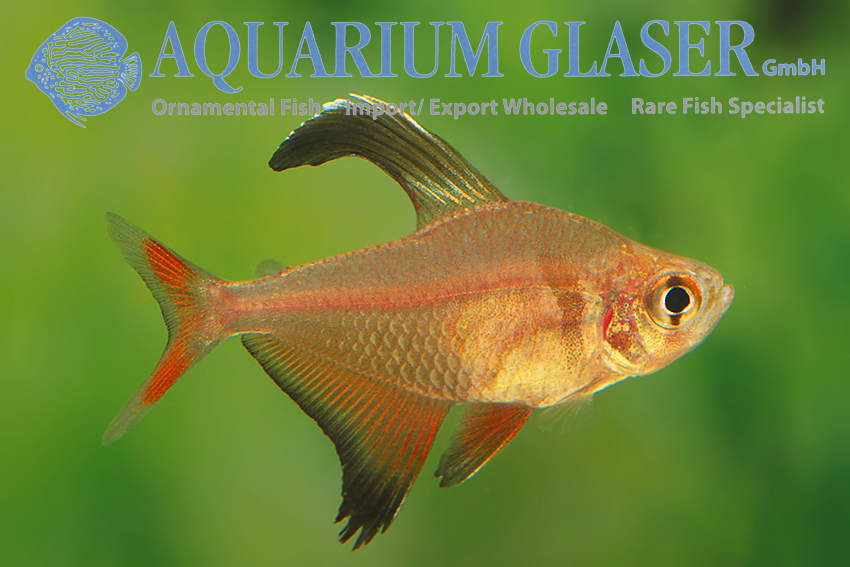
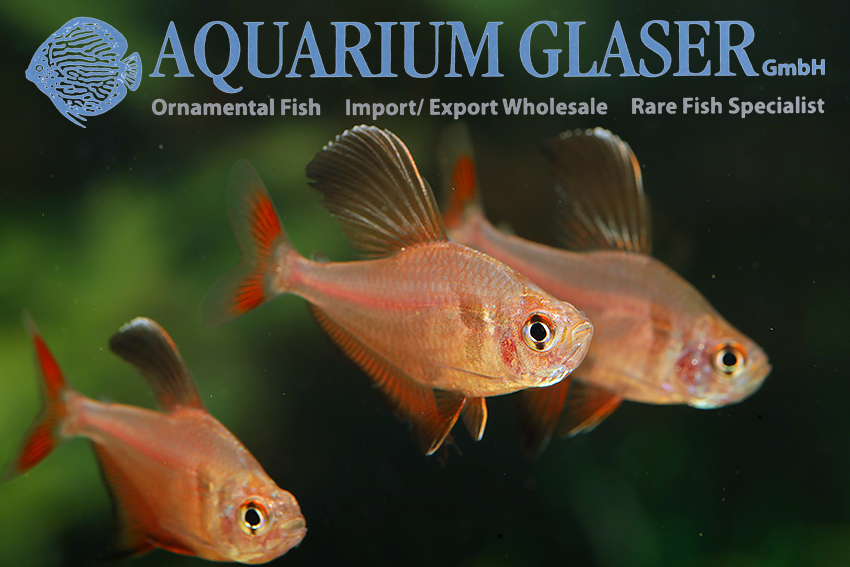
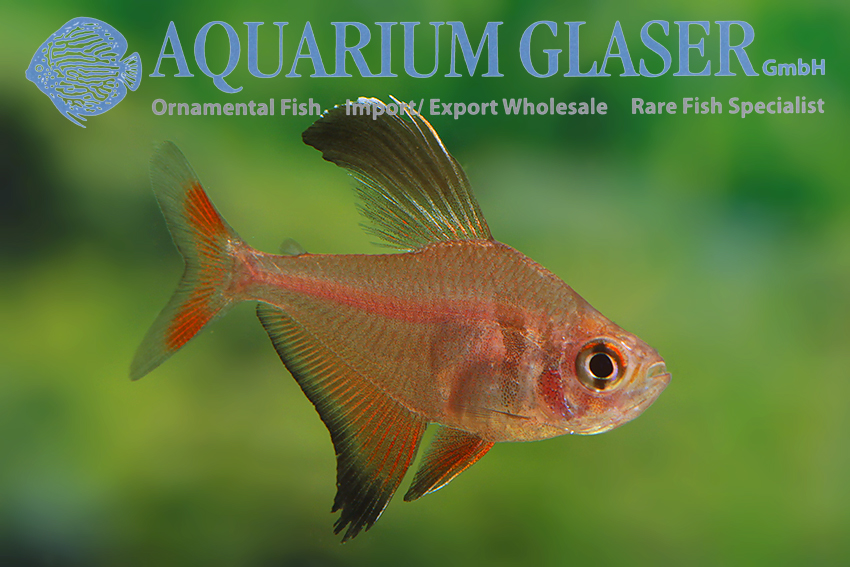
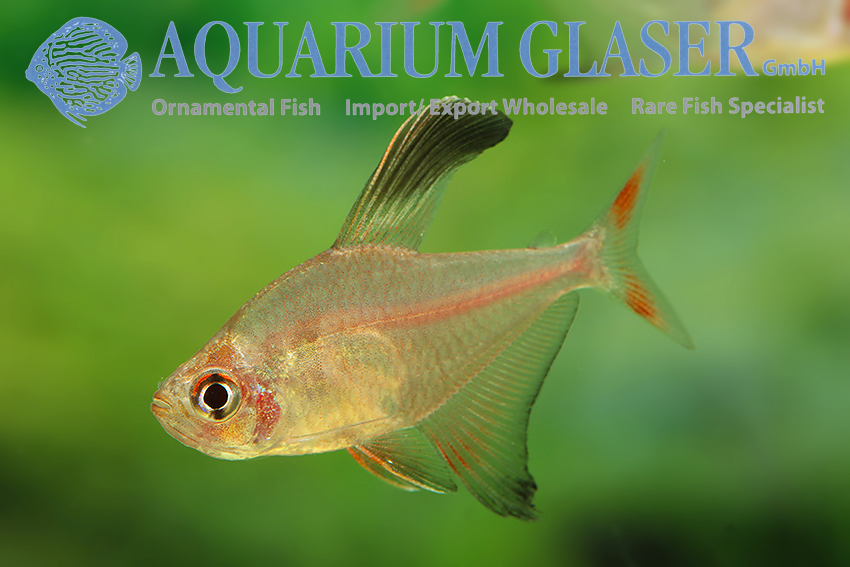
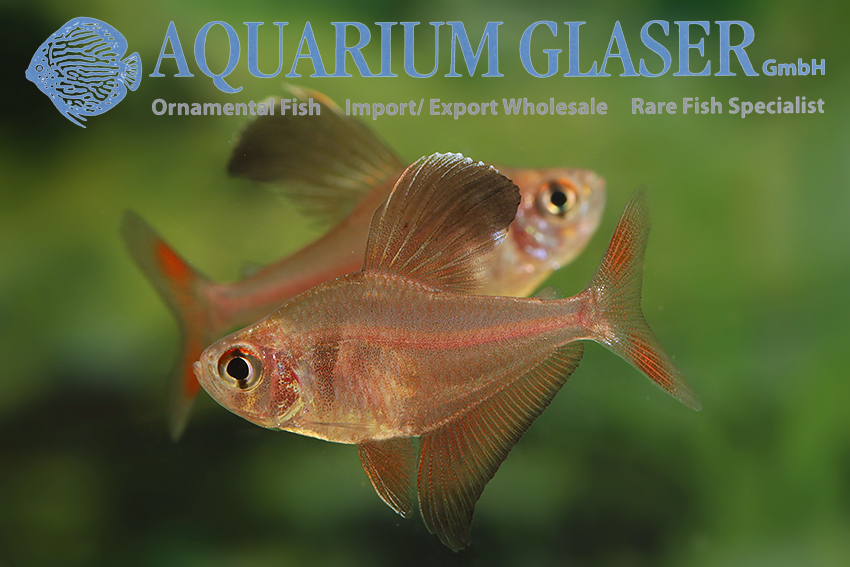
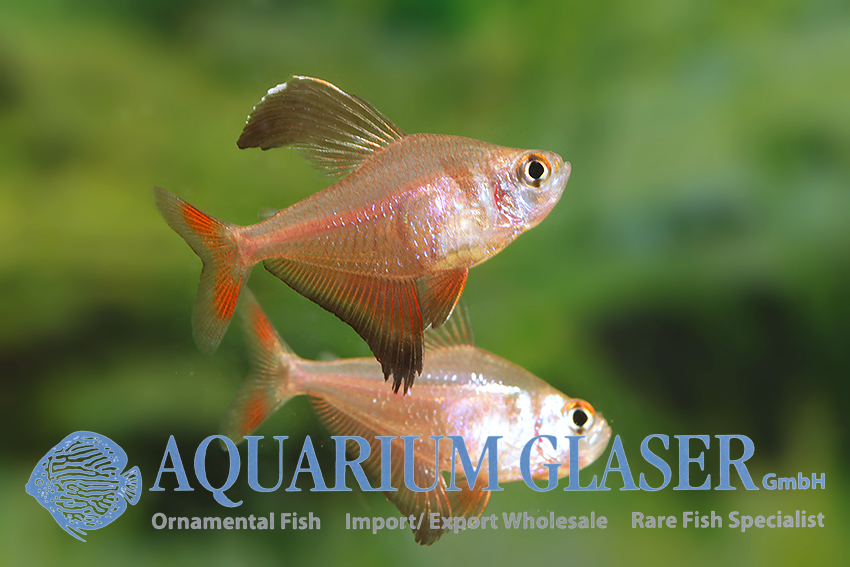
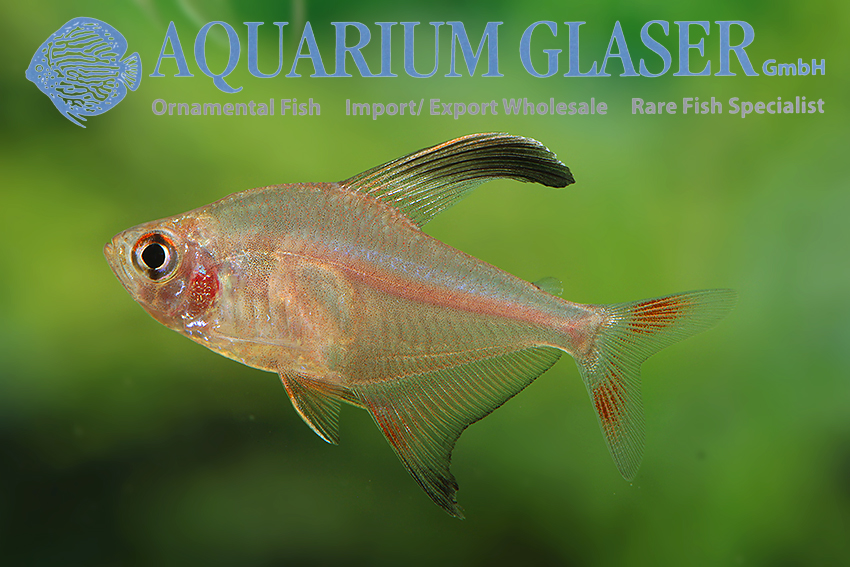
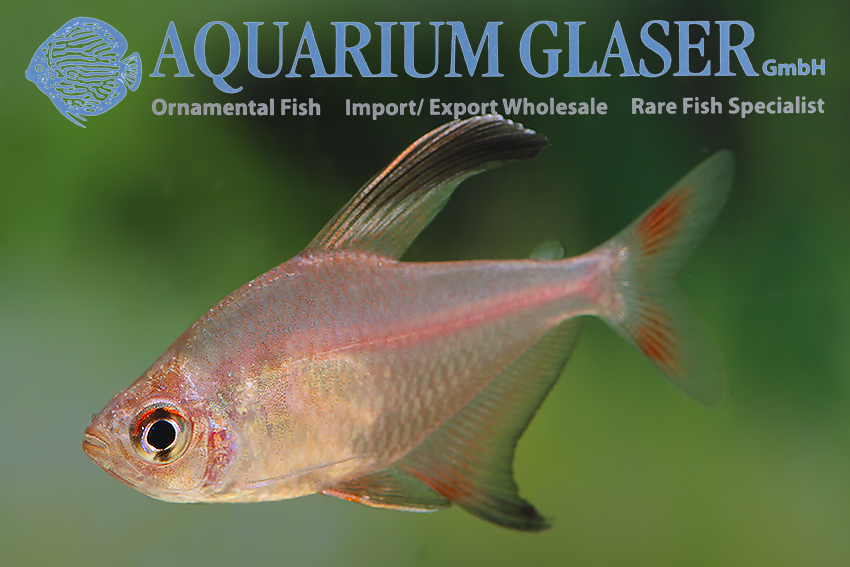
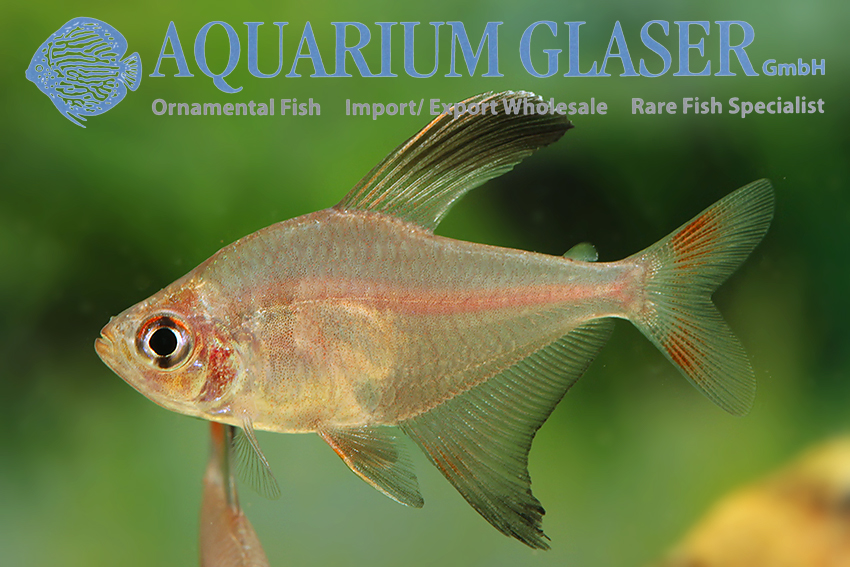
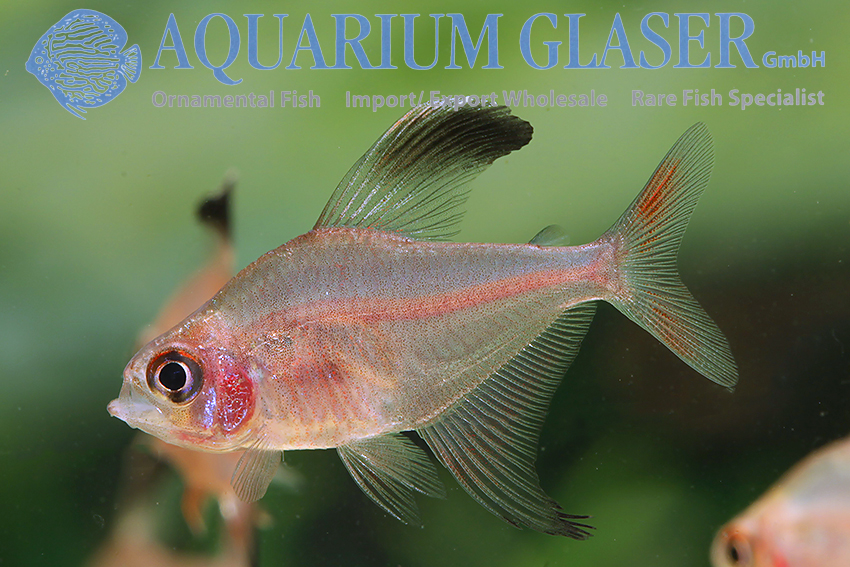
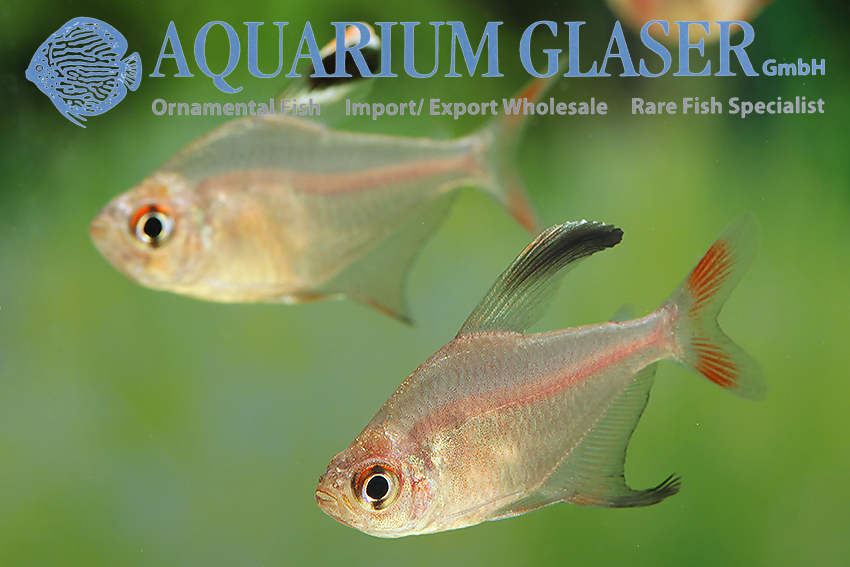
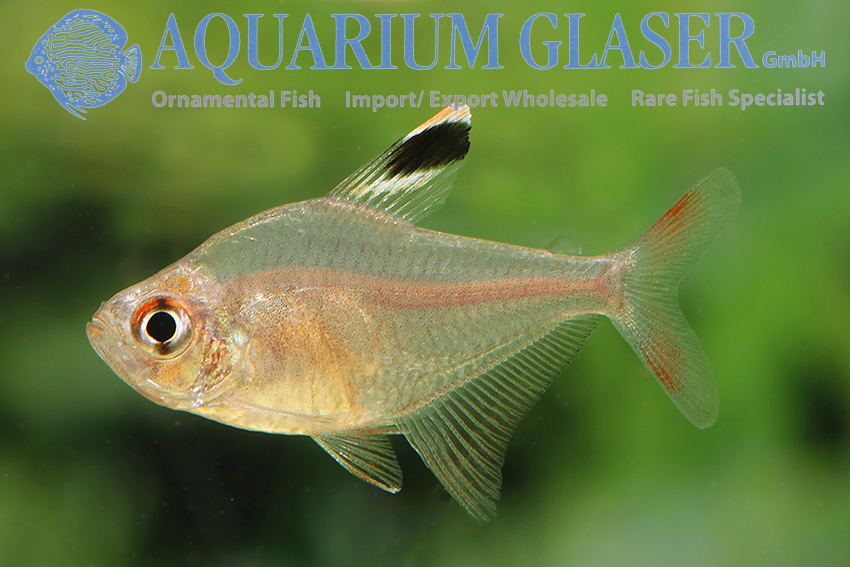
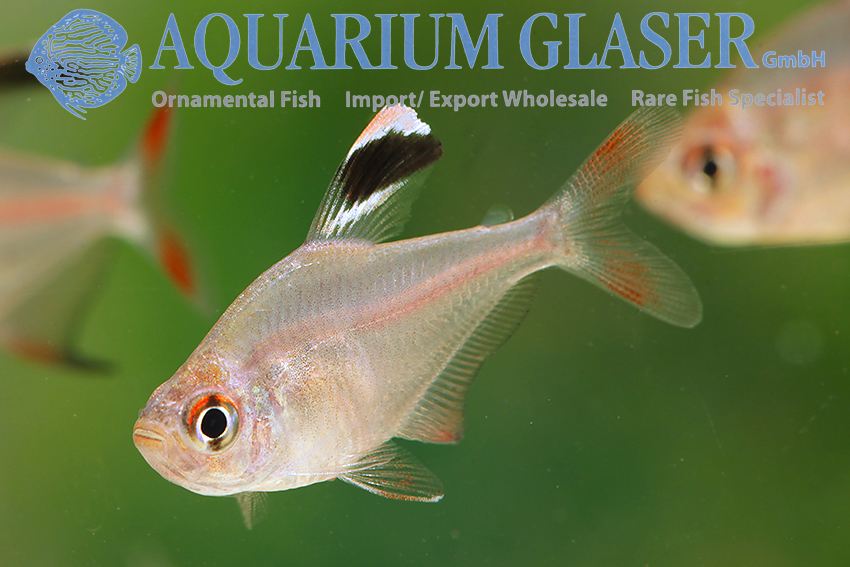
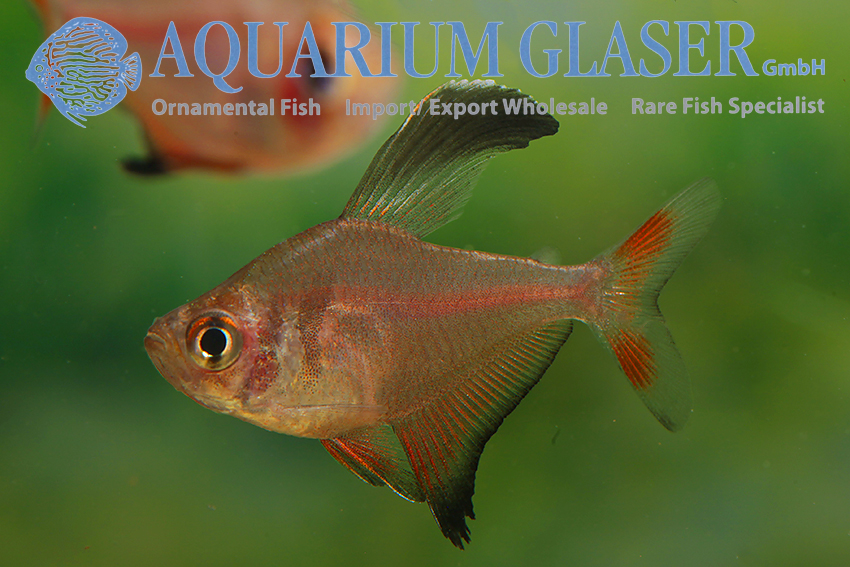
Then Axel Zarske of the Senckenberg Museum presented a new study in 2014 in which he identified differences between Hyphessobrycon bentosi and the robertsi-tetra. He concluded that the two belong to different species and described the robertsi-tetra with the valid name Hyphessobrycon jackrobertsi. With this Zarske honors the discoverer of the species, Jack Roberts from Miami, who was already meant with the invalid name “robertsi”.
We just have again beautiful young adult wild specimens of the species in the stock. The type specimens for the first description of H. jackrobertsi originated also from our fishhouse.
For our customers: the animals have code 261703 on our stocklist. Please note that we supply exclusively to wholesalers.
Text & Photos: Frank Schäfer
Cyphocharax multilineatus
This interesting species, which we obtained from Venezuela, belongs to the Curimata-relationship. At the first glimps it reminds one strongly to the well known headstander (Chilodus punctatus), but it can be easily recognized by the black stripe through the eye. Moreover, Cyphocharax swims in a “normal” horizontal way.
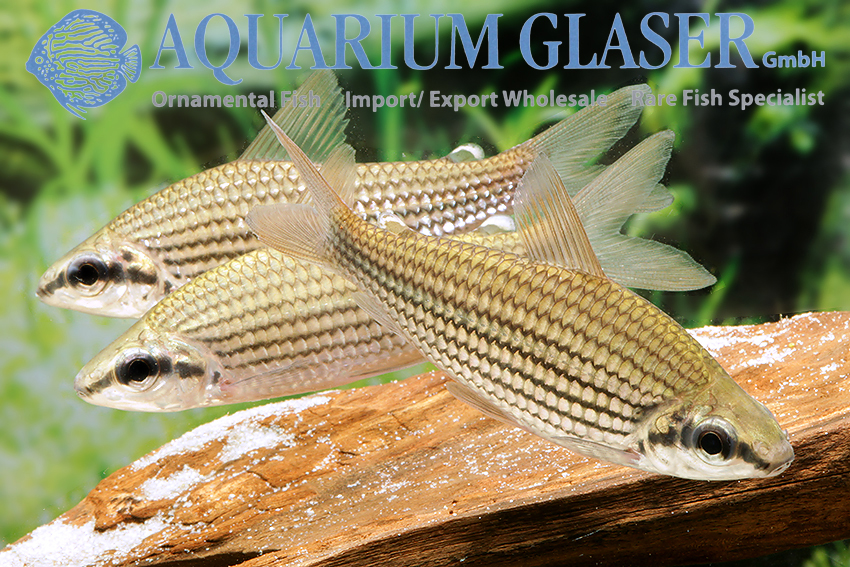
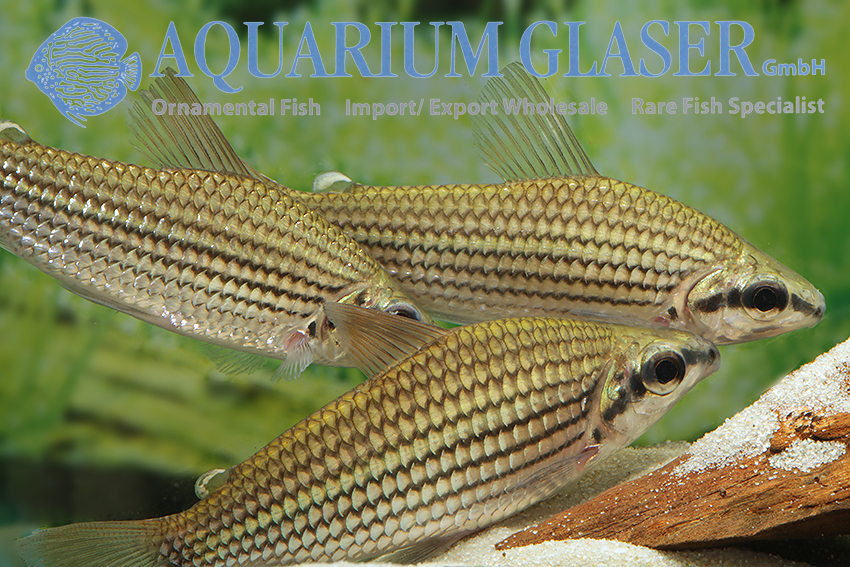
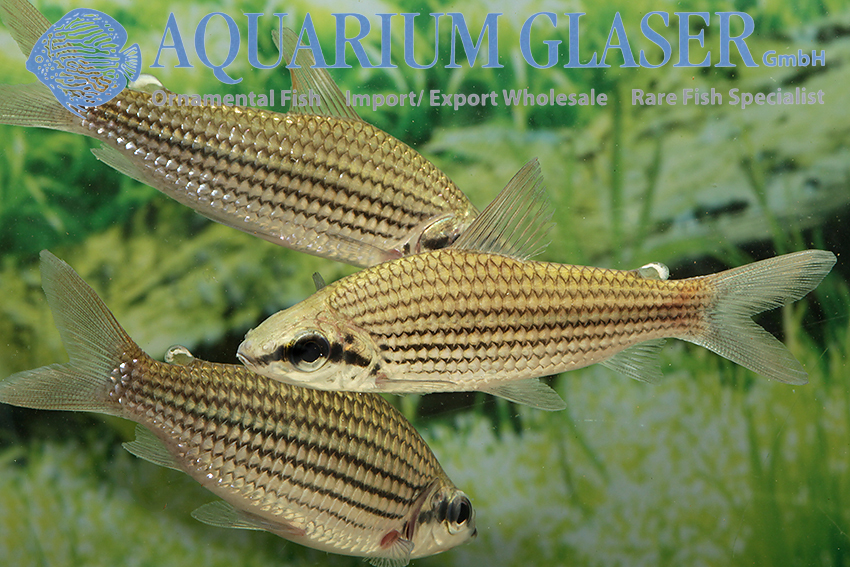
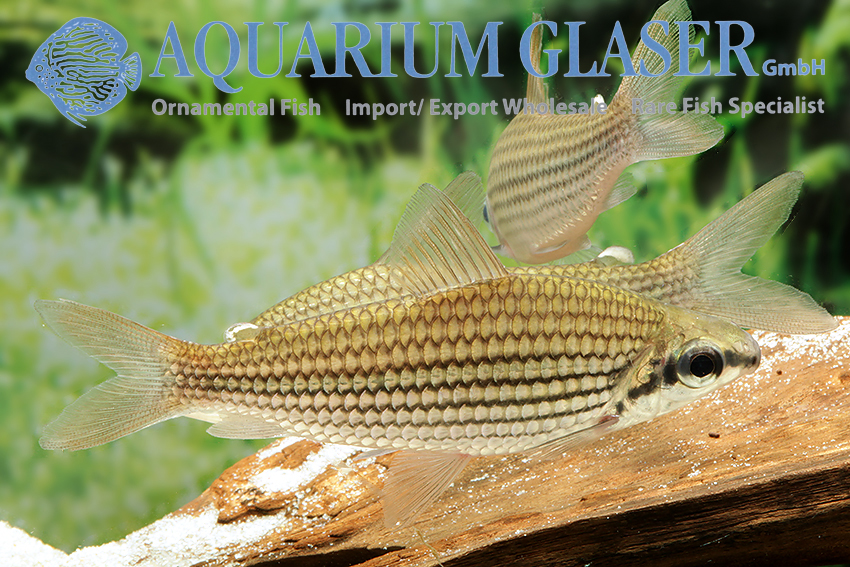
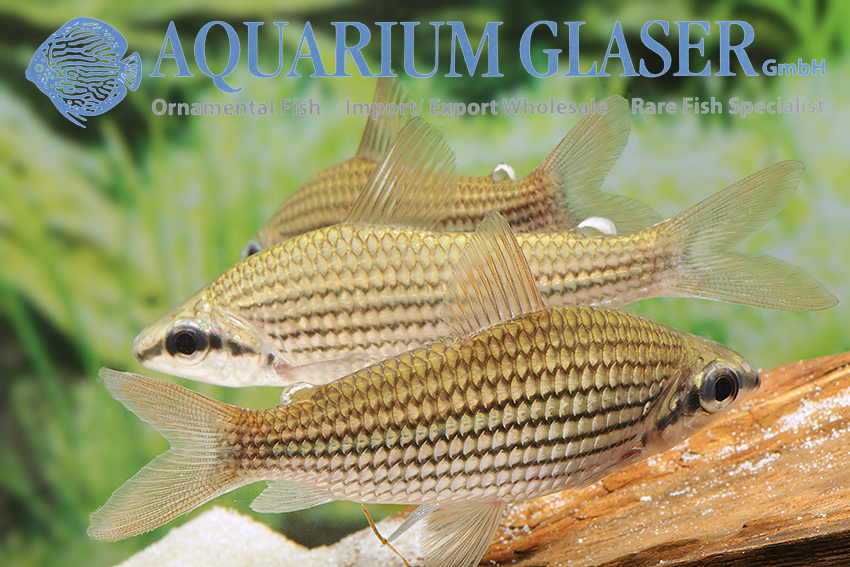
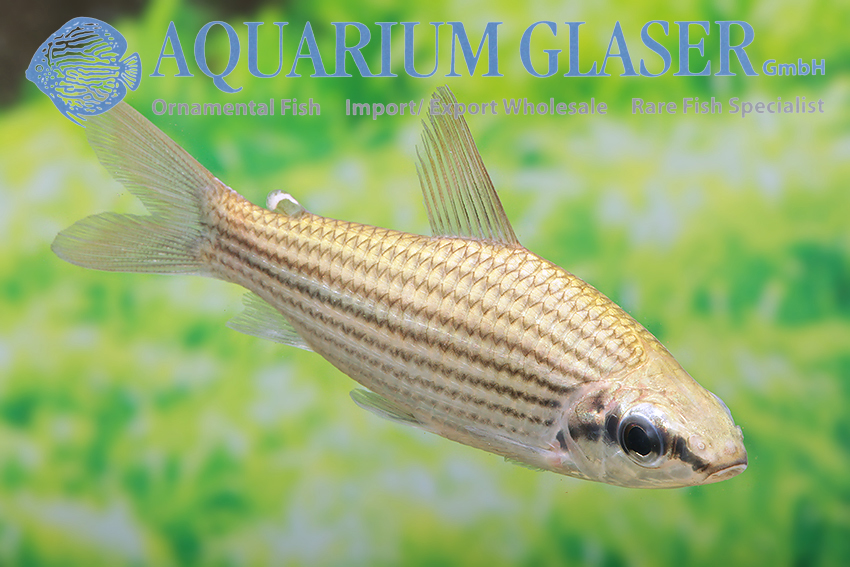
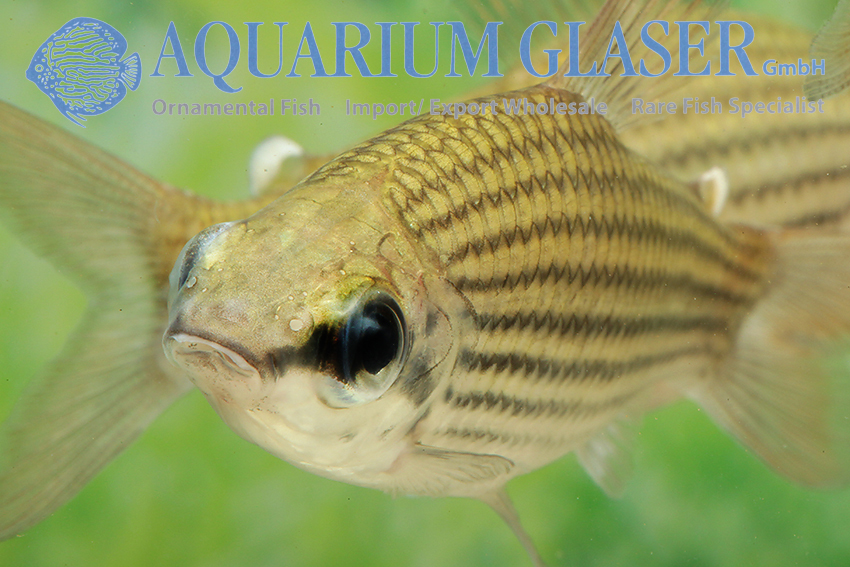
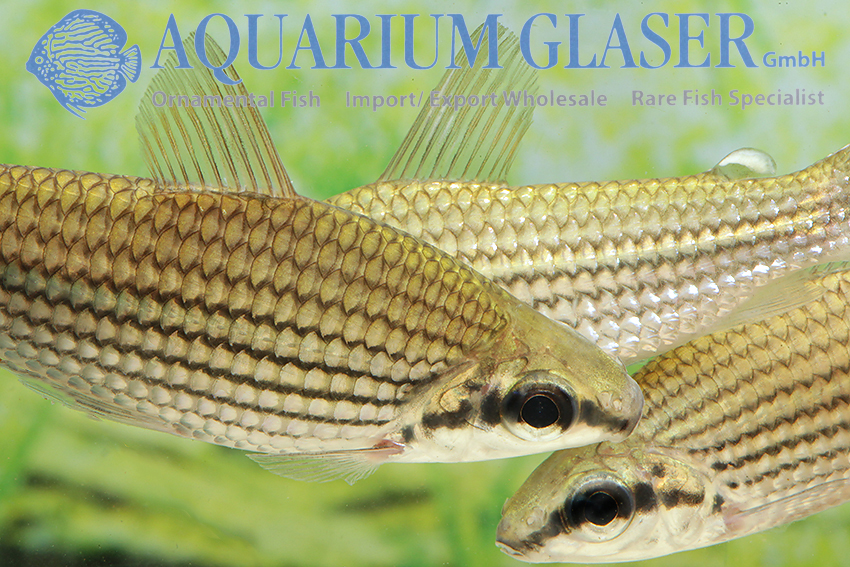
Cyphocharax feed on Aufwuchs and look the whole day through on stones, roots, and plants for algae and the small animals inside them. Against each other C. multilineatus are very peaceful. Maximum length reported for the species is about 10 cm.
We have also made a small film about these fish, which you can watch here: https://www.youtube.com/watch?v=9uaKiKAcnTI
For our customers: the fish has code 251353 on our stocklist. Please note that we exclusively supply the wholesale trade.
Lexicon: Cyphocharax: from ancient Greek, means “Charax with a hump”; Charax is another genus of tetra. multilineatus: Latin, means “with many stripes”. Chilodus: ancient Greek, means “with teeth on the lips”. punctatus: Latin, means “spotted”.
Suggestion of a common name: Golden Mascara Tetra
Text & photos: Frank Schäfer
Hypomasticus julii
In 1996, ichthyologists Santos, Jegu, and Lima described an unusual Leporinus from the Rio Xingu and Trombetas as L. julii. The new species is closely related to L. pachycheilus, an extremely color variable Leporinus species. Unique to L. julii, which was named in honor of Júlio Garavello, is the completely underslung mouth and teeth position. In 2008 the subgenus Hypomasticus, which was already established for Leporinus mormyrops in 1929, was elevated to generic rank and 12 species from the large collective genus Leporinus were assigned to it.
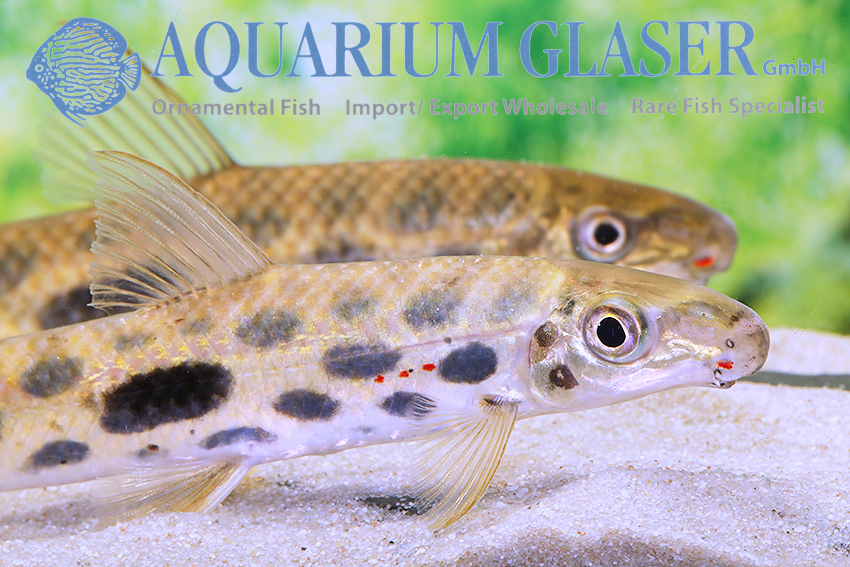
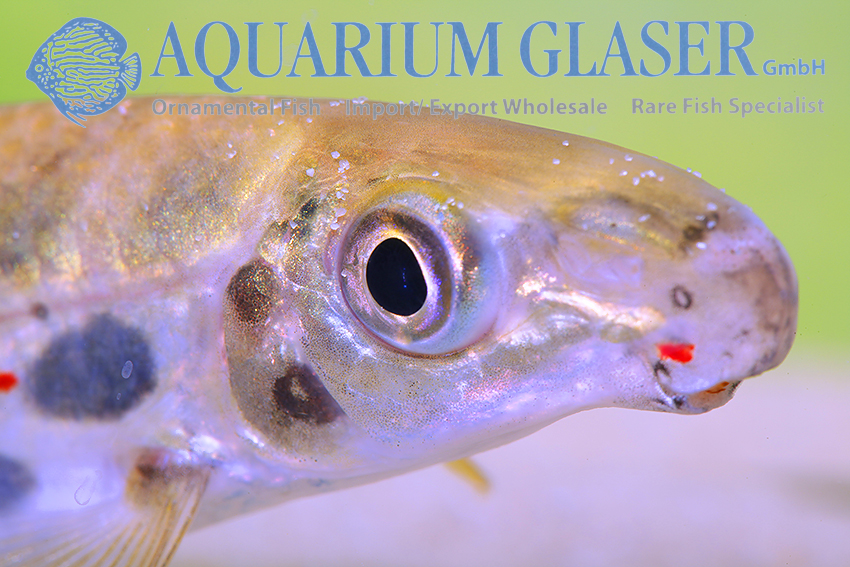
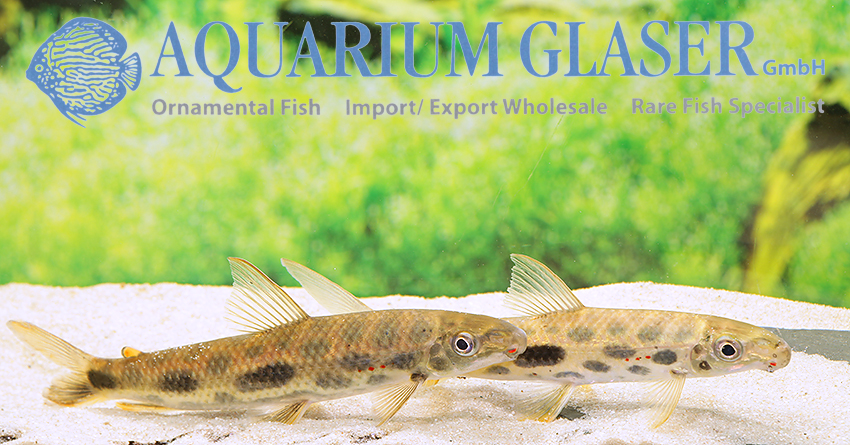
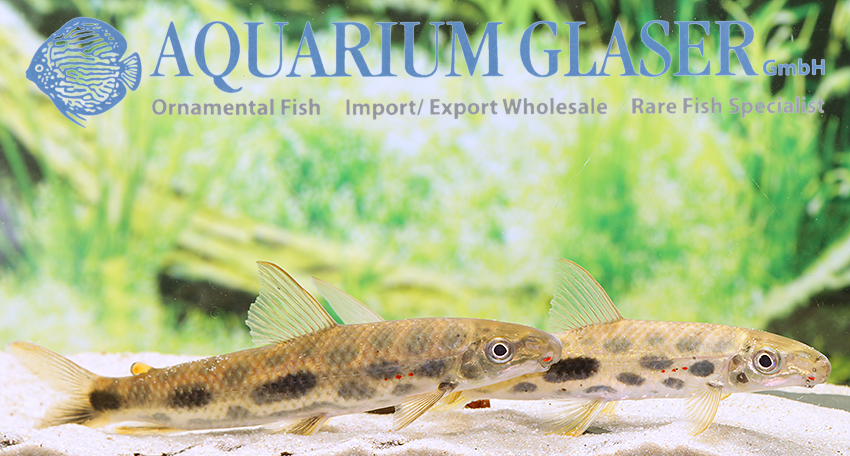
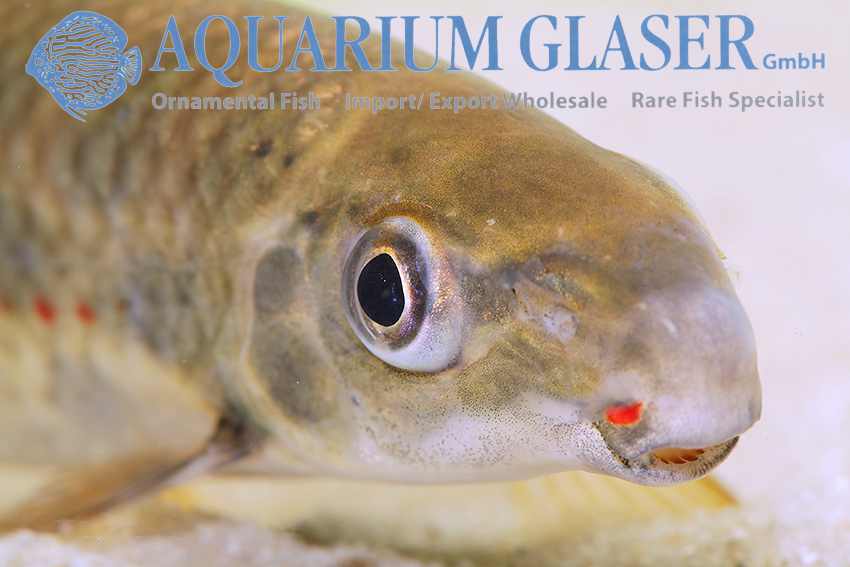
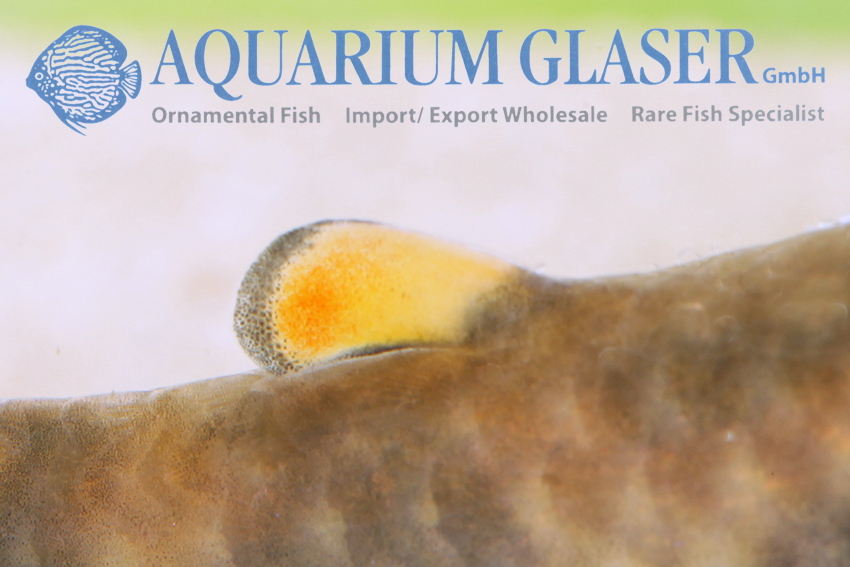
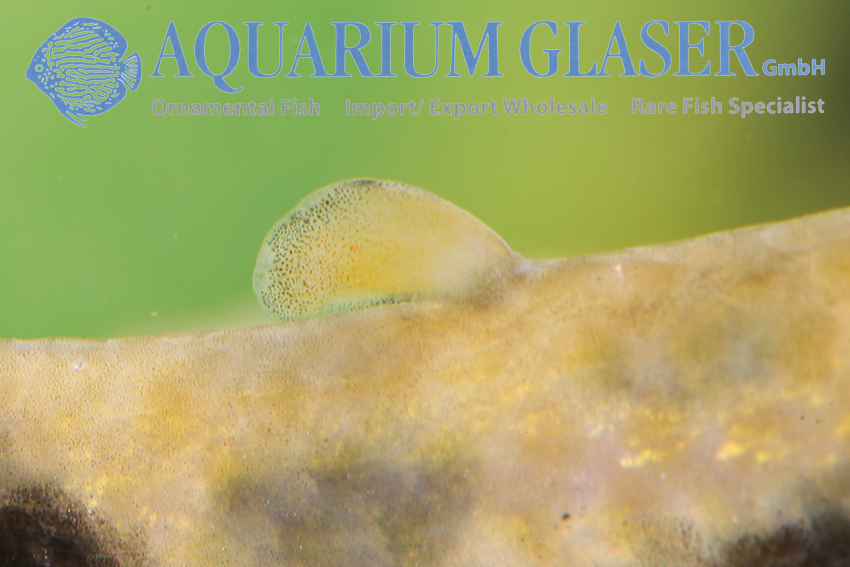
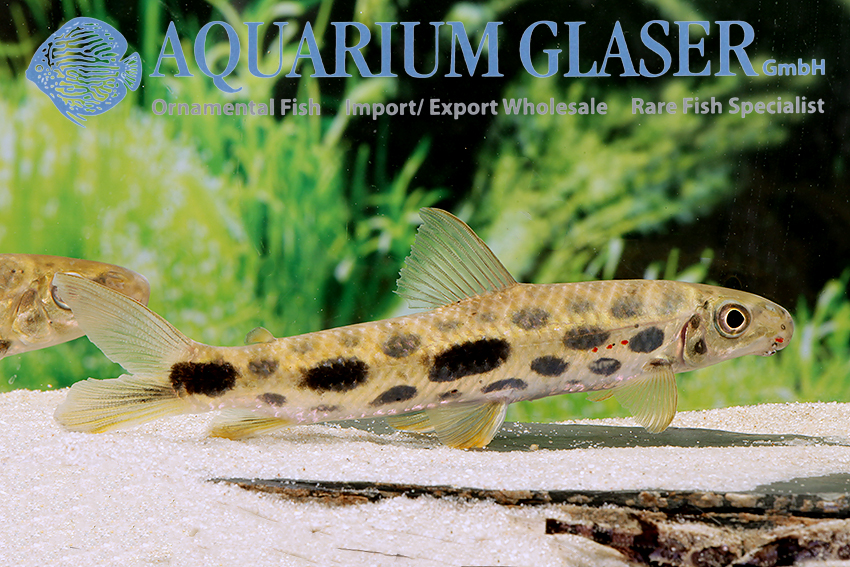
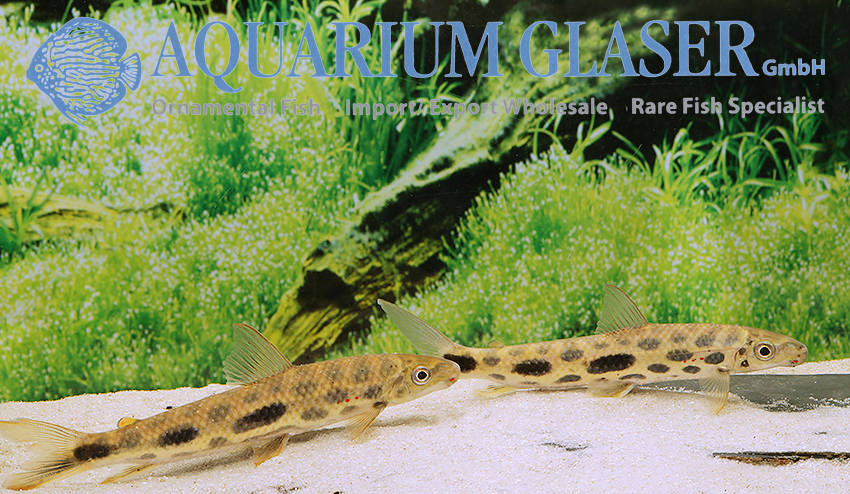
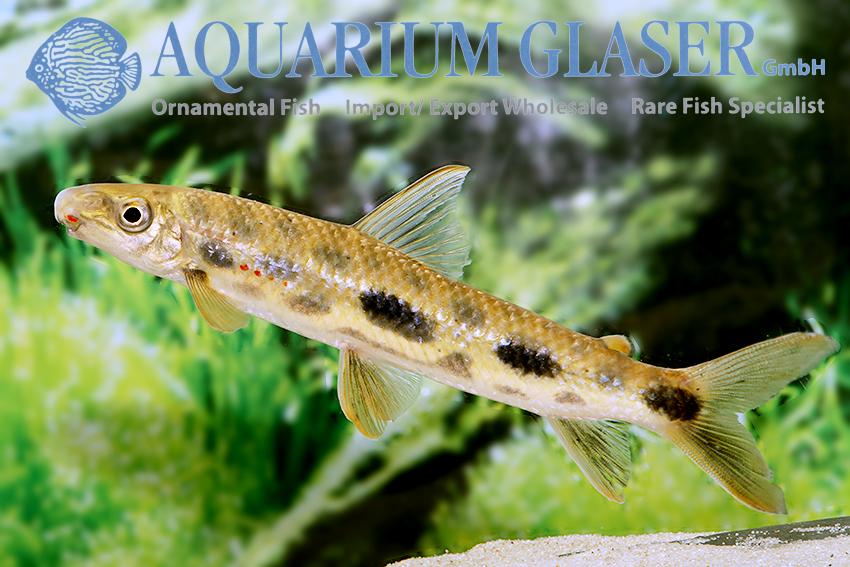
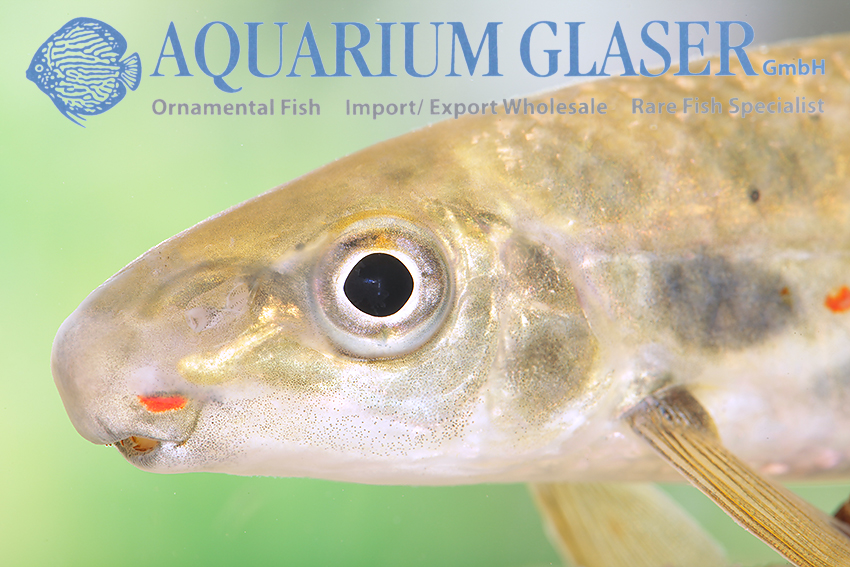
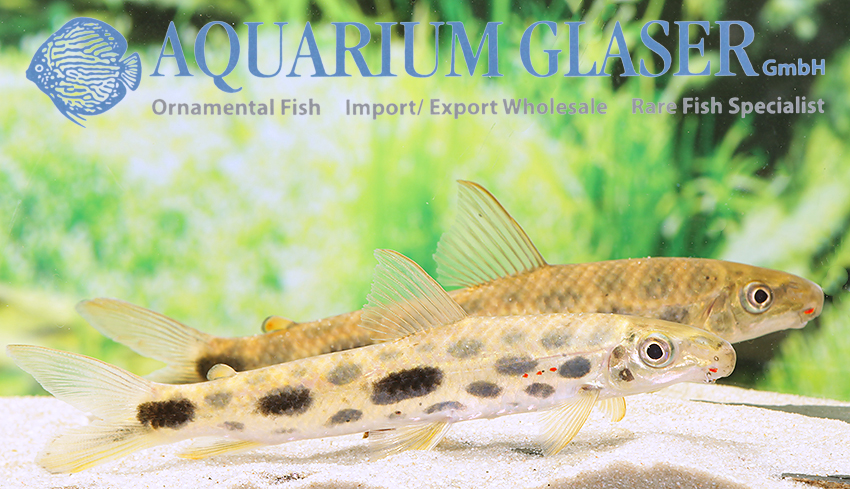
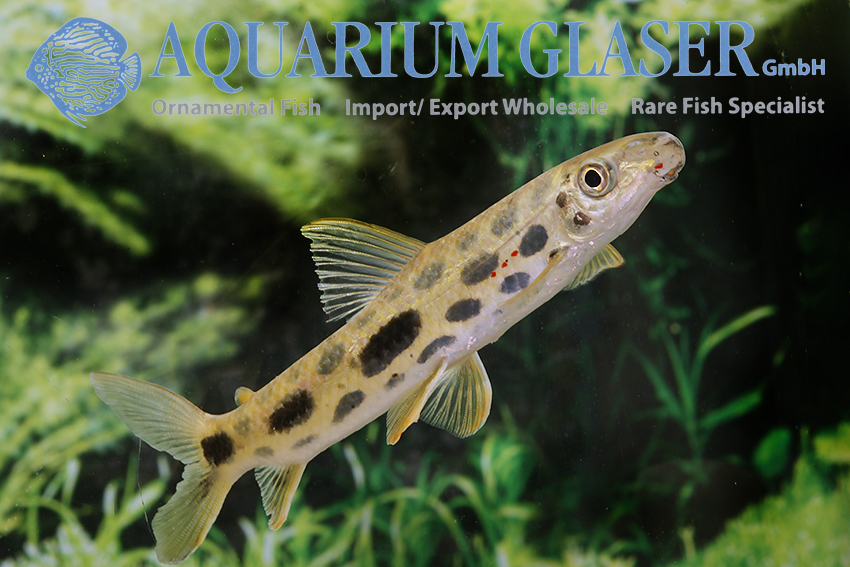
For the first time we were able to import 2 specimens of this rapids inhabitant from the Rio Xingu. In the photographic aquarium they behaved like two too large ground tetras, sitting on the bottom and supporting themselves with their strong pelvic fins. It can be assumed that in nature they have to swim strongly against the current and graze stones. Our two specimens are somewhat differently colored, one animal is darker than the other and has a strikingly different colored adipose fin. We do not know if this is a sex difference.
In the photographic aquarium the animals, in which intense red spots in the corner of the mouth and in the shoulder area are very conspicuous color features, were rather uninterested in each other, but the darker animal shooed the lighter specimen energetically out of its immediate vicinity after a certain period of acclimation. Because of the known tendency of Leporinus to quarrel, we have housed them separately in our fish house anyway.
The maximum length of the species is about 20 cm (standard length without tail fin).
For our customers: the animals have code 262205 on our stocklist. Please note that we only supply wholesale.
Text & photos: Frank Schäfer
- 1
- 2
- 3
- …
- 5
- Next Page »





